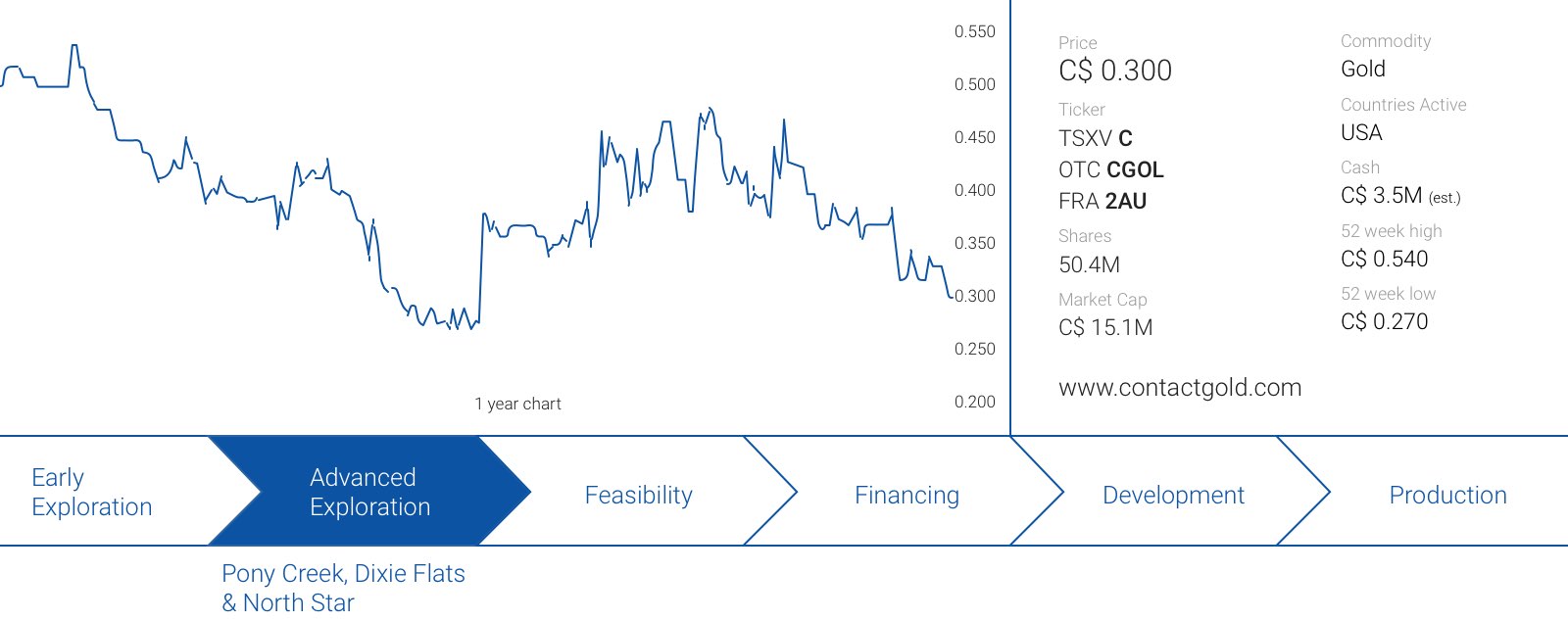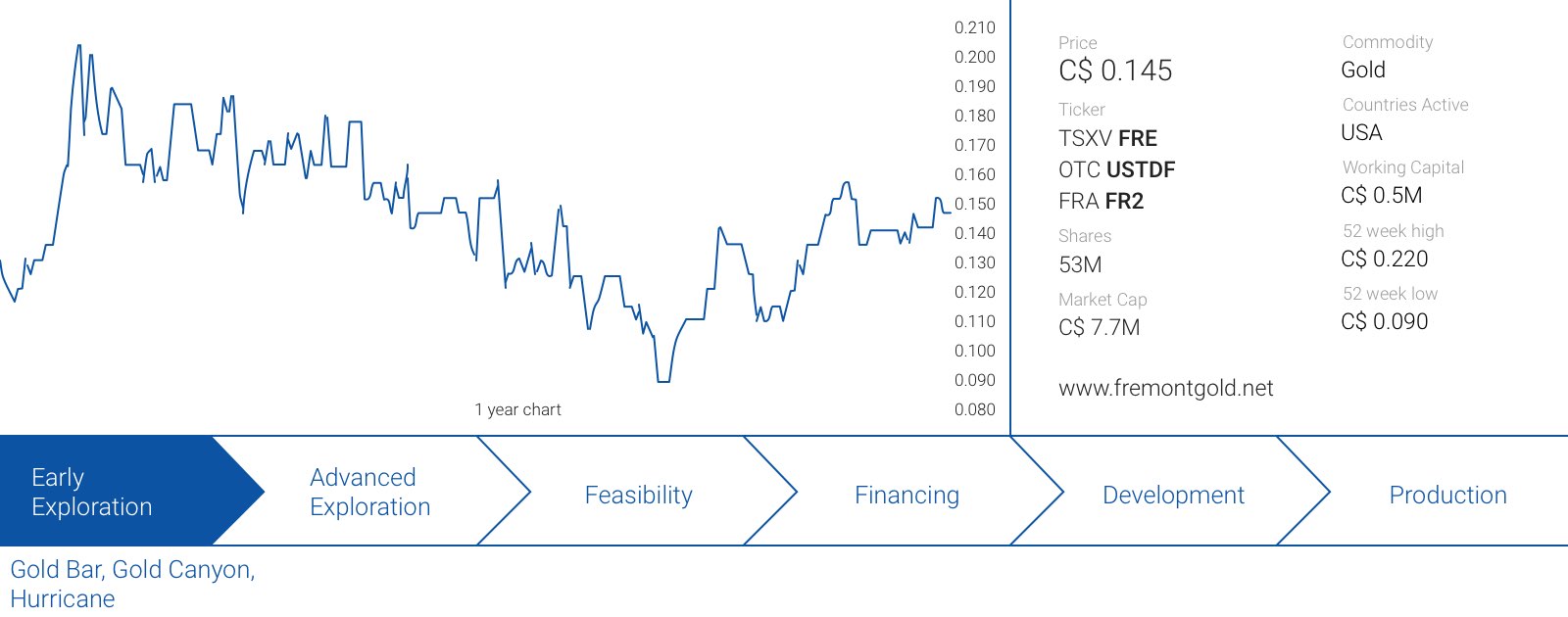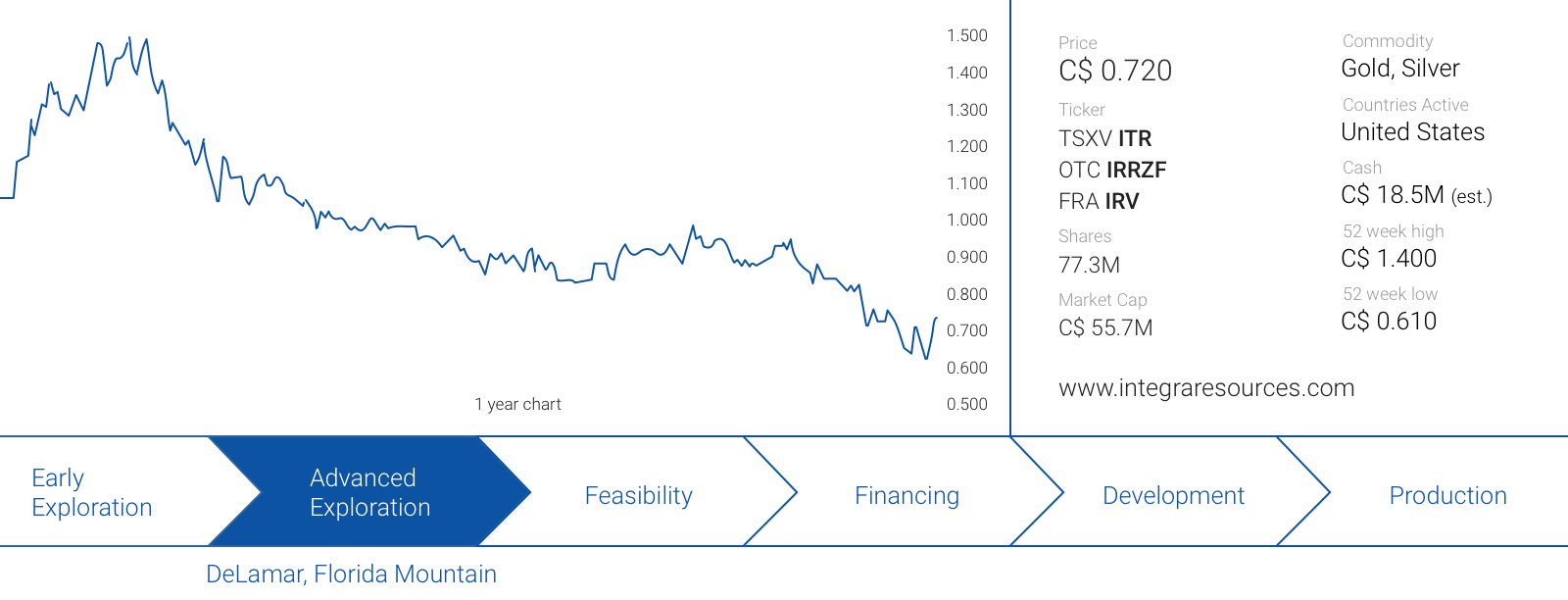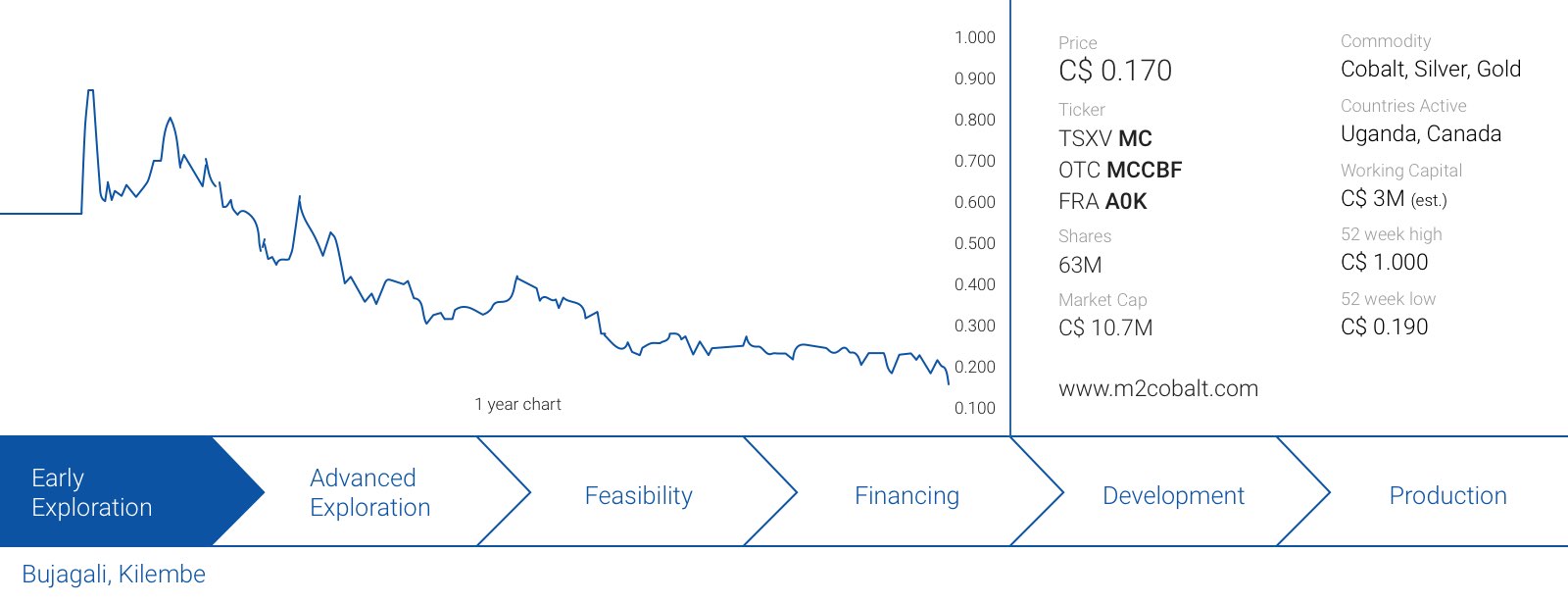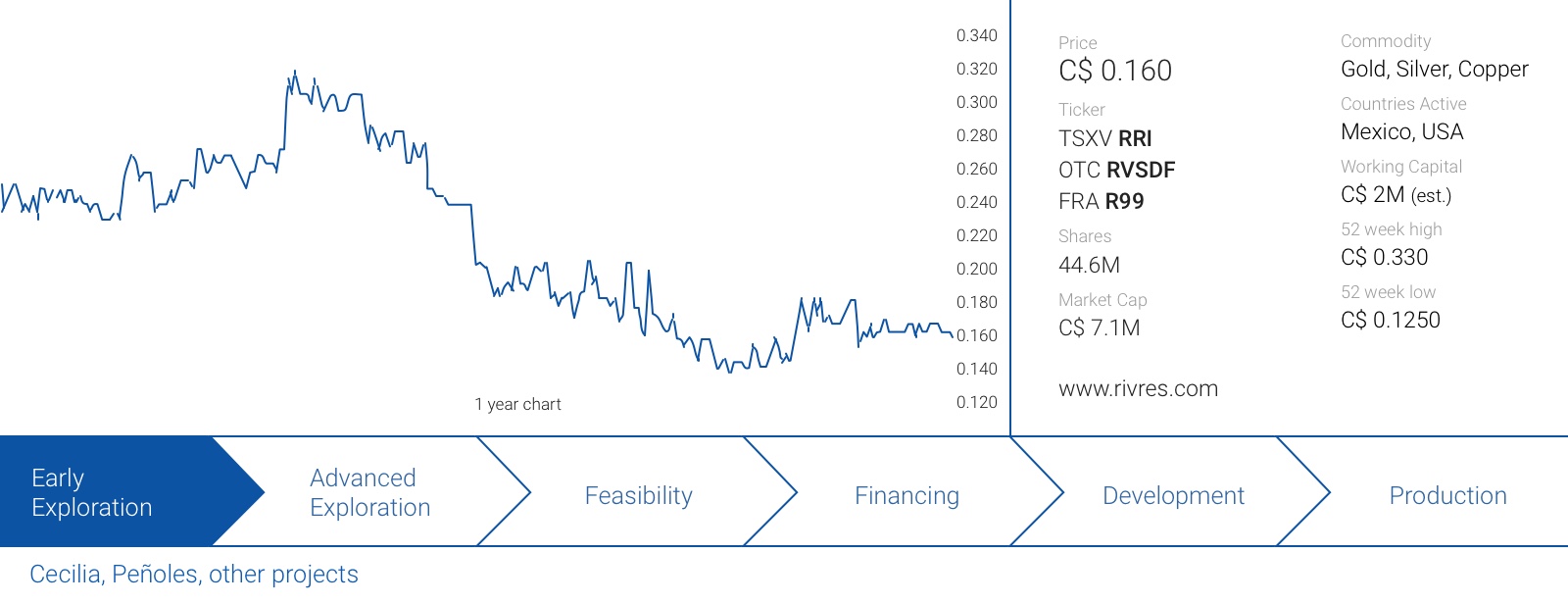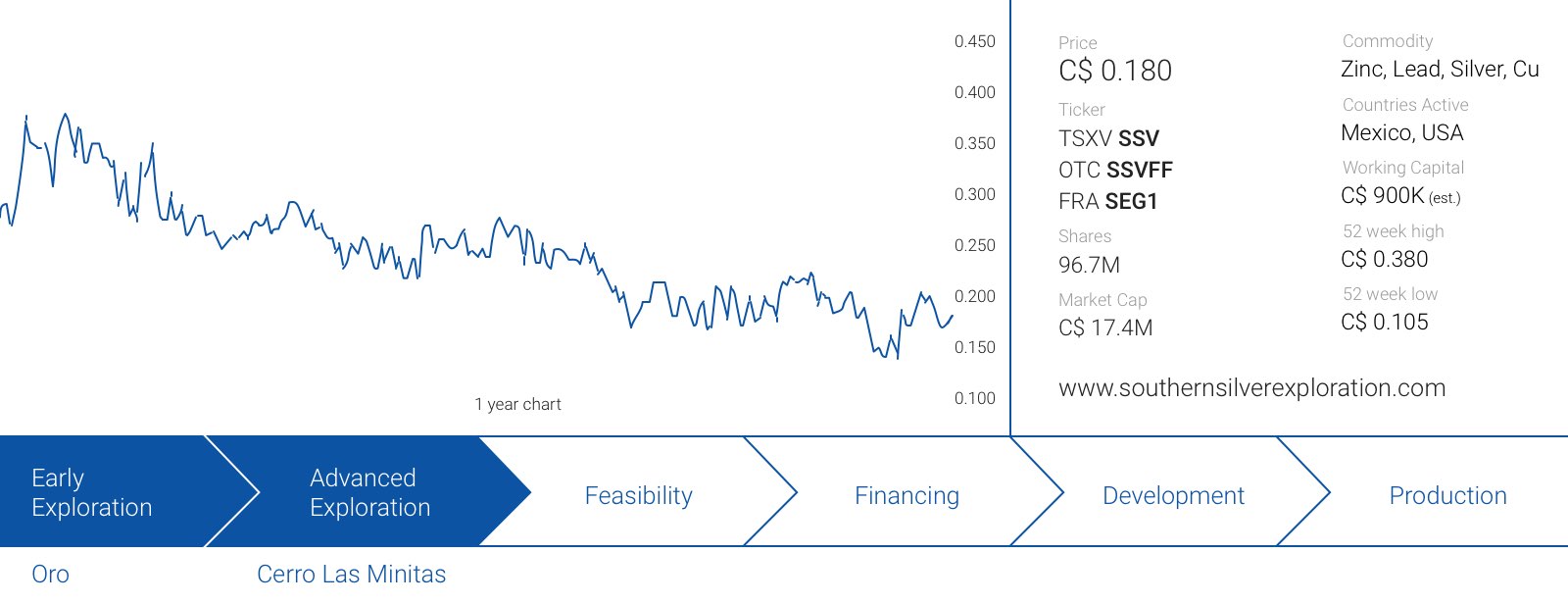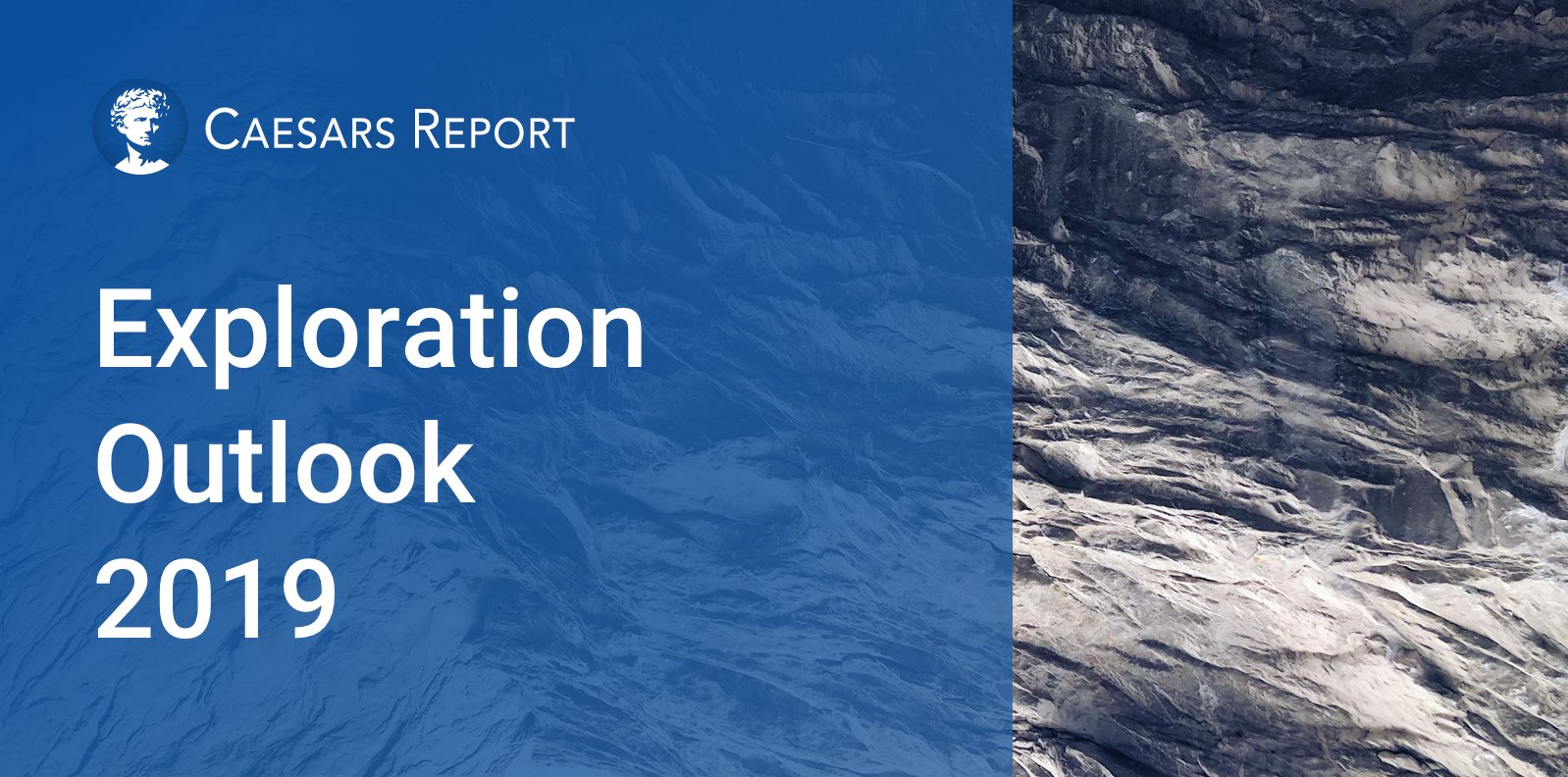
2018 is almost over and it wasn’t a great year for the natural resources sector. Some metals did very well, but this didn’t mean the share price of the companies moved along with the commodity price increases. Gold appears to be ending the year on a (relatively) strong note, but the gold equities remain weak. Silver and oil seem to have found a bottom but the equity markets still appear to be a bit cautious.
The tax loss selling season is almost over, and we think that whoever wanted to sell, has already sold by now, which could indicate the share prices may stabilize from here on and could benefit from investors taking new positions. UBS has recently released its precious metals outlook for 2019, and it’s interesting to see the Swiss bank is now expecting the gold price to average $1300/oz in 2019. That would be a great result for most gold miners and developers, but the UBS report doesn’t really provide any support for the silver sector. The bank has slashed its 2019 silver price forecast from $17/oz to just $15.8/oz, and it looks like we will see some more mine closures in 2019 as some miners can no longer justify keeping some of their mines open due to selling their silver at a loss.
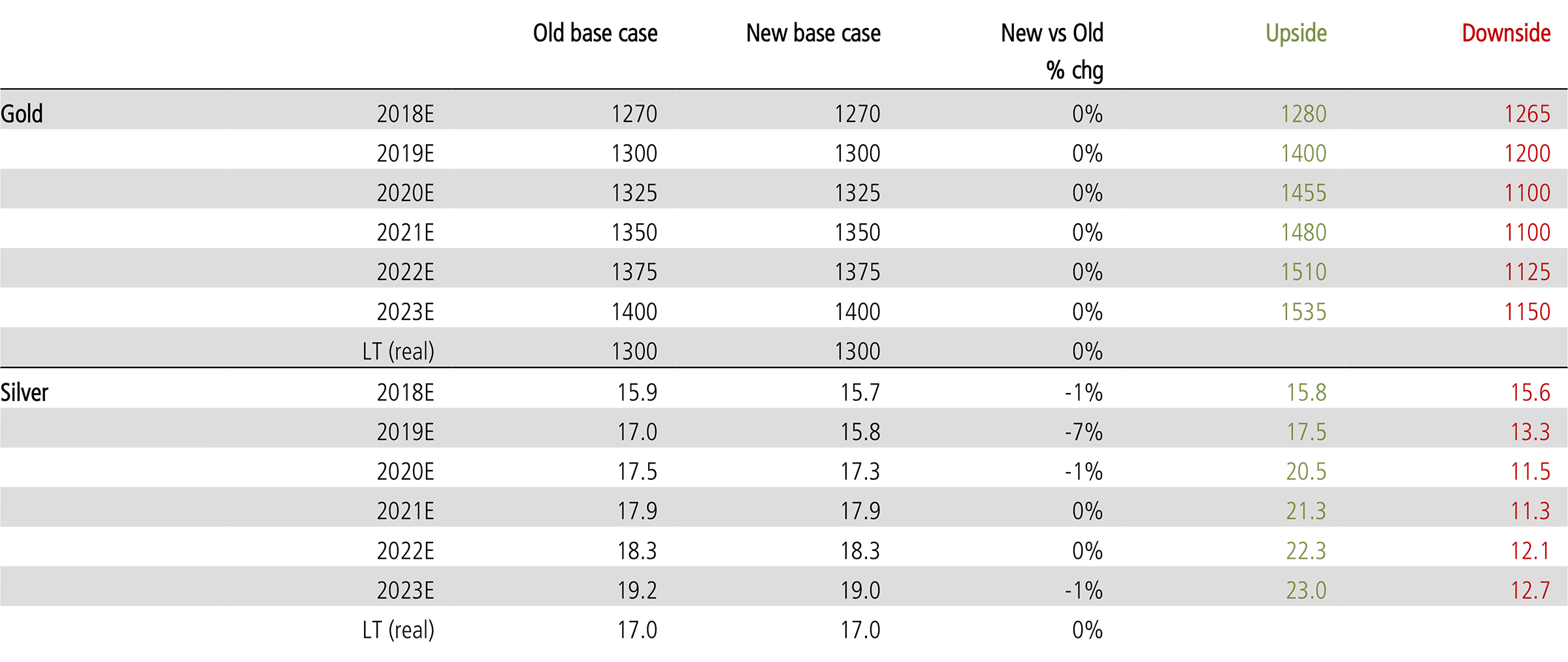
Caesars Report is able to exist thanks to the companies sponsoring our mining portal. In this special exploration outlook report we are highlighting our sponsoring companies and have asked them the same three questions; how was 2018, what do you expect for 2019 and what are your projections for the commodity you focus on? All answers were provided by the companies and we pulled the other data (share count and cash position) from the company’s most recent presentations.
Enjoy the read, and happy holidays!

Aben Resources
Avrupa Minerals
Blue Sky Uranium
Brixton Metals
Callinex Mines
Contact Gold
Cypress Development
Elysee Development
Fremont Gold
Great Bear Resources
Inca One Gold
Integra Resources
Jericho Oil
Kutcho Copper
M2 Cobalt
Medallion Resources
Riverside Resources
Skyharbour Resources
Southern Silver Exploration

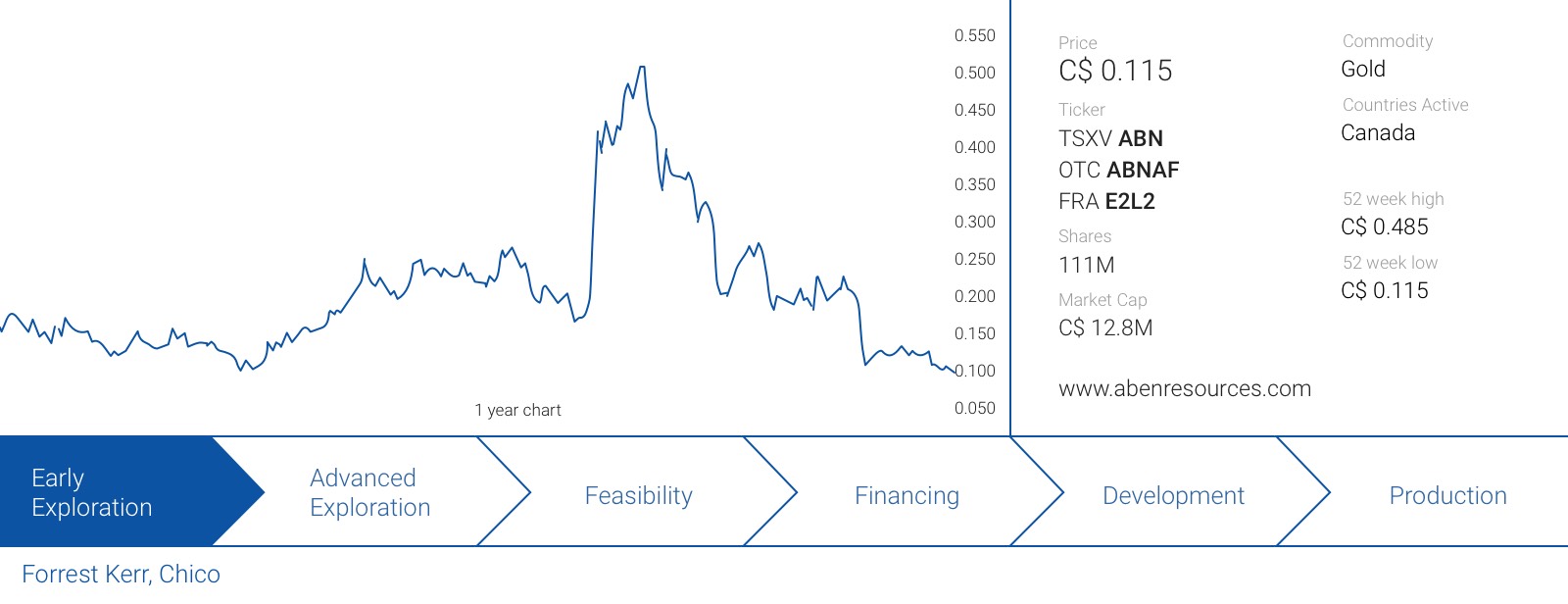
Aben Resources (ABN.V) had a roller coaster year as excellent initial drill results with high-grade gold sent the stock soaring over the summer, but the market appeared to be unimpressed by the follow-up drill results. Aben’s management team was smart enough to cash up on the back of the good drill results, and approximately half of the current share price is backed by hard dollars in the bank. This means the company should be fully funded for the 2019 exploration season in the Golden Triangle, but it will also advance its Justin gold project in the Yukon and the Chico gold project in Saskatchewan. Getting back to work on the Saskatchewan project should help the company to provide a year-round news flow instead of being hindered by the seasonal exploration campaigns in the Golden Triangle.
Could you review 2018 for us? What did you work on, and what did the company achieve in the past 12 months?
Aben completed almost 10,000 meters of drilling at Forrest Kerr, the company’s gold project in British Columbia’s Golden Triangle. The company had a major discovery hole in August as drilling encountered 6 meters of 62.4 g/t gold within 10 meters of 38.7 g/t gold. The company is excited about these results and continues to work on the geological model at Forrest Kerr. The 9,900 meters of NQ drilling completed in 2018 will be a great help to connect the dots.
The geology is complex; however, ABN has plenty of cash in the treasury to continue to unlock the theory. After the initial excellent assay results, ABN was able to attract Eric Sprott as a new investor in Aben Resources. Sprott participated in a C$4.3M hard dollar financing priced at C$0.30, while the company raised an additional C$950,000 in flow-through funds at C$0.40. ABN currently has approximately C$5.5M in cash on the bank.
What will 2019 bring? What will you be working on and what budget do you have in mind?
ABN continues to drill the flagship Forrest Kerr gold project, but also expects to do some work on the Chico property in Saskatchewan (where ABN can earn an 80% stake) and the Justin gold project in the Yukon Territory where the company completed a field program last summer.
That field program indicated the presence of visible gold in trenches and channel samples, and the team on the ground thinks the type of mineralization it encountered could be similar to Golden Predator’s (GPY.V) 3 Aces property.
What’s your near-term and longer-term outlook for your main commodity?
With recent equity and credit market volatility, the price of Gold could be expected to perform well in 2019 and beyond.

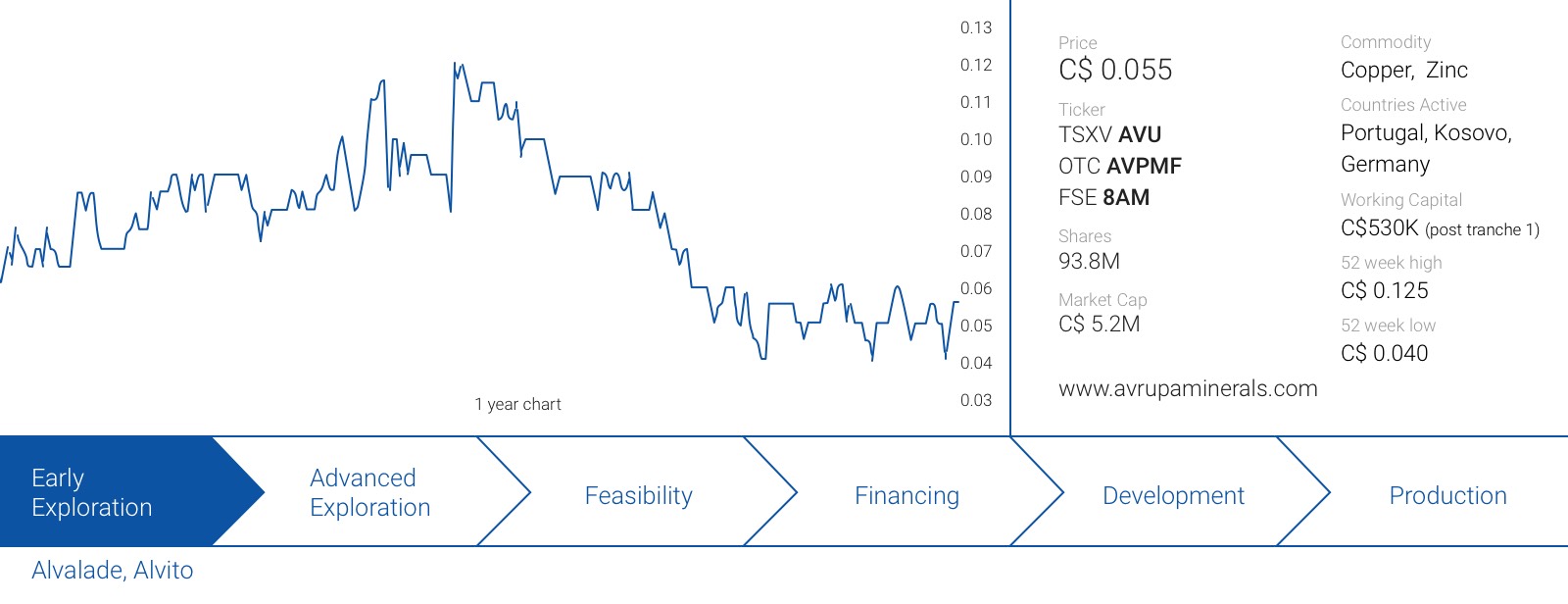
We recently released a report on Avrupa Minerals (AVU.V) (read it here), which is a Europe-focused prospect generator focusing on gold and base metals. The majority of the company’s projects are located in Portugal where a drill program on the Alvalade project is currently underway. We asked Mark Brown, Executive Chairman, the same three questions.
Could you review 2018 for us? What did you work on, and what did the company achieve in the past 12 months?
We had a very busy year in Portugal where we completed the field work and a drill program on our Alvito IOCG project. The activities were funded by OZ Minerals (OZL.AX) as part of their earn-in agreement. However, OZ dropped the option and returned the project to us after spending in excess of 1 million euros, even though the earn in was for AUD$1m.
We are also advancing our Alvalade project in Portugal which was drill-ready. We had initially hoped to complete some partner-funded work on Alvalade, but the final decision on the previously-announced 13M EUR option agreement with a major North American copper company hasn’t been concluded yet. We didn’t want to wait for Godot and are currently in the process of raising C$1.5M in a private placement priced at C$0.05. C$500,000 of the financing has already closed, and the two drill rigs have been mobilized to site where the drill program is well underway.
We are still hoping to complete that 13M EUR joint venture agreement which would include 10M EUR earmarked for Alvalade with an additional 2M EUR to be spent on Marateca and 1M EUR on Mertola. It’s needless to say this would be a major boost for our exploration plans on these projects.
What will 2019 bring? What will you be working on and what budget do you have in mind?
As our drill program on the Alvalade project is in full swing, we hope to have the assay results out in January/February and this will tell us more about our exploration theory. Irrespective of whether or not the Alvalade drilling yields the desired results, we will continue to pursue the 13M EUR option deal with the large copper company.
Also in Portugal we will review the assay results from Alvito and re-market the project to potential joint venture partners.
In Kosovo, we will be looking to monetize our interest in the Slivovo gold project, which we have been able to keep above the 10% threshold, the critical level before it would be converted into a 2% Net Smelter Royalty. If we are indeed successful in selling our stake, we anticipate reinvesting the proceeds in additional exploration programs in Kosovo, as we think this region provides excellent exploration potential.
While we are now mainly focused on Kosovo and Portugal, we are looking to broaden our horizons and are actively looking in other mining-friendly jurisdictions in Europe and North Africa.
What’s your near-term and longer-term outlook for your main commodity?
Avrupa is exploring for base and precious metals:
We expect gold to continue at current or higher levels based on the effects of the US dollar and strengthening based on expansion in demand and reductions in supply.
Base metals are in a similar situation and we expect Zinc and Copper to have a very positive year, with additional upside due to potential production interruptions at some of the larger mines (but those are short lived).

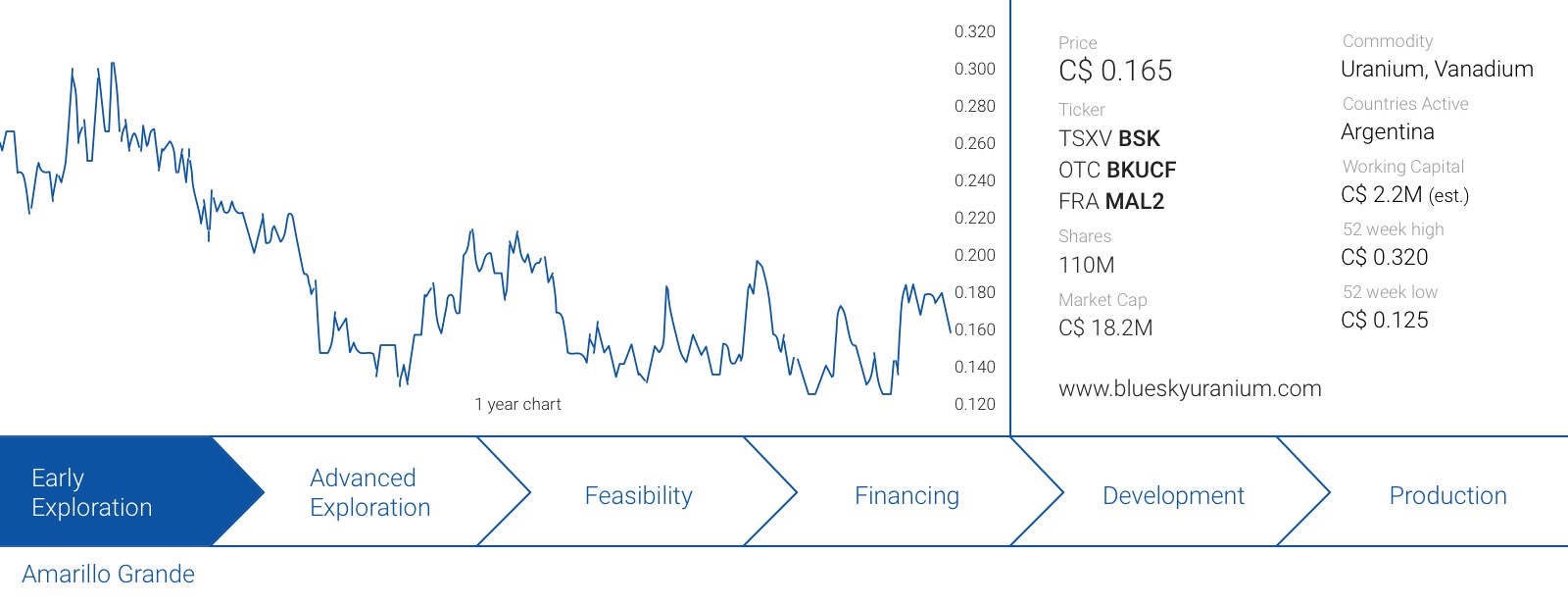 We expect 2019 to be an important year for the uranium market and the companies focusing on this commodity. The tendering activity from US utilities should start to pick up next year and especially now Cameco has become a net buyer on the spot market to meet their contractual obligations, we think the oversupply on the spot market is going down really fast which will result in higher spot prices which, in turn, should cause the longer term contract price to increase as well.
We expect 2019 to be an important year for the uranium market and the companies focusing on this commodity. The tendering activity from US utilities should start to pick up next year and especially now Cameco has become a net buyer on the spot market to meet their contractual obligations, we think the oversupply on the spot market is going down really fast which will result in higher spot prices which, in turn, should cause the longer term contract price to increase as well.
Blue Sky Uranium (BSK.V) released its maiden resource estimate on the Amarillo Grande uranium-vanadium project earlier this year, and the recent exploration updates have been very encouraging as the company continues to encounter mineralization outside of the current resource. We asked Blue Sky Uranium the same three questions.
Could you review 2018 for us? What did you work on, and what did the company achieve in the past 12 months?
Blue Sky Uranium Corp. is a leader in uranium discovery in Argentina. The Company’s objective is to deliver exceptional returns to shareholders by rapidly advancing a portfolio of surficial uranium deposits into low-cost producers. Blue Sky holds the exclusive right to properties in two provinces in Argentina. The Company’s flagship Amarillo Grande Project was an in-house discovery of a new district that has the potential to be both a leading domestic supplier of uranium to the growing Argentine market and a new international market supplier.
The Ivana uranium-vanadium deposit is the largest discovery in Argentina in the last 50 years and the districtwide potential makes Amarillo Grande one of the most significant uranium discoveries in the world. The company filed the maiden NI 43-101 Technical Report supporting disclosure of the initial independent mineral resource estimate for the Ivana Deposit at the Company’s 100% owned Amarillo Grande Uranium-Vanadium Project in Rio Negro Province, Argentina, as reported on March 5th, 2018.
The Ivana mineral resource estimate is the first for the Amarillo Grande Project. The deposit is situated within five properties of less than 7,000 hectares in total, covering the southern portion of the 140-km uranium-vanadium exploration trend, within which Blue Sky Uranium controls over 280,000 hectares of mineral exploration rights.
Through additional drilling and exploration work, the company recently reported high grades of uranium and vanadium in initial pit samples located a kilometre west of the Ivana Uranium-Vanadium deposit over 1% U3O8 and 0.1% V205. This clearly supports that the deposit is open to expansion potential.
Guillermo Pensado, Vice President of Exploration, received the “Explorer of the Year” Nivaldo Rojas Award at the 2018 Argentina Mining conference for the Uranium/Vanadium discovery and maiden resource. Nominees for the award are put forth and voted on by members of the exploration and mining community attending the annual conference, which is the premium international event of the Argentinean mining sector.
What will 2019 bring? What will you be working on and what budget do you have in mind?
Blue Sky will continue work to expand the resource with an aggressive work program. The Company will be announcing the metallurgical test results and the Preliminary Economic assessment in the first part of the New Year with of a focus of moving toward to production.
We will have funding requirements in the New Year so your readership should stay tuned in case they would be interested to participate in a financing.
What’s your near-term and longer-term outlook for Uranium (and the Argentinean uranium market)?
Argentina is a natural market with an existing nuclear power plant fleet that is currently under expansion and yet no domestic mine production of uranium. Argentina remains pro-mining.
Blue Sky expects to be the first supplier to feed the country’s current uranium requirements and be there for the near term expansion. Blue Sky Uranium is the ideal uranium development story in Argentina. The company’s main assets are in a pro-mining province and at some distance from any substantial settlement (Rio Negro province).
As expected the unmet demand will be just less than one billion pounds of U3O8 in the coming 10 years. At the same time, over 70% of the expected reactor needs are not contractually secured. For a little traded commodity like uranium this return to more “normal” long term contracts could put tremendous pressure on the long-term prices as well as on the spot prices. The international plant operators are showing buying signals.
We expect world demand will increase sharply due to the construction of several hundred new nuclear reactors so that the market price will benefit twofold as well as the investor who has recognized that trend in time.

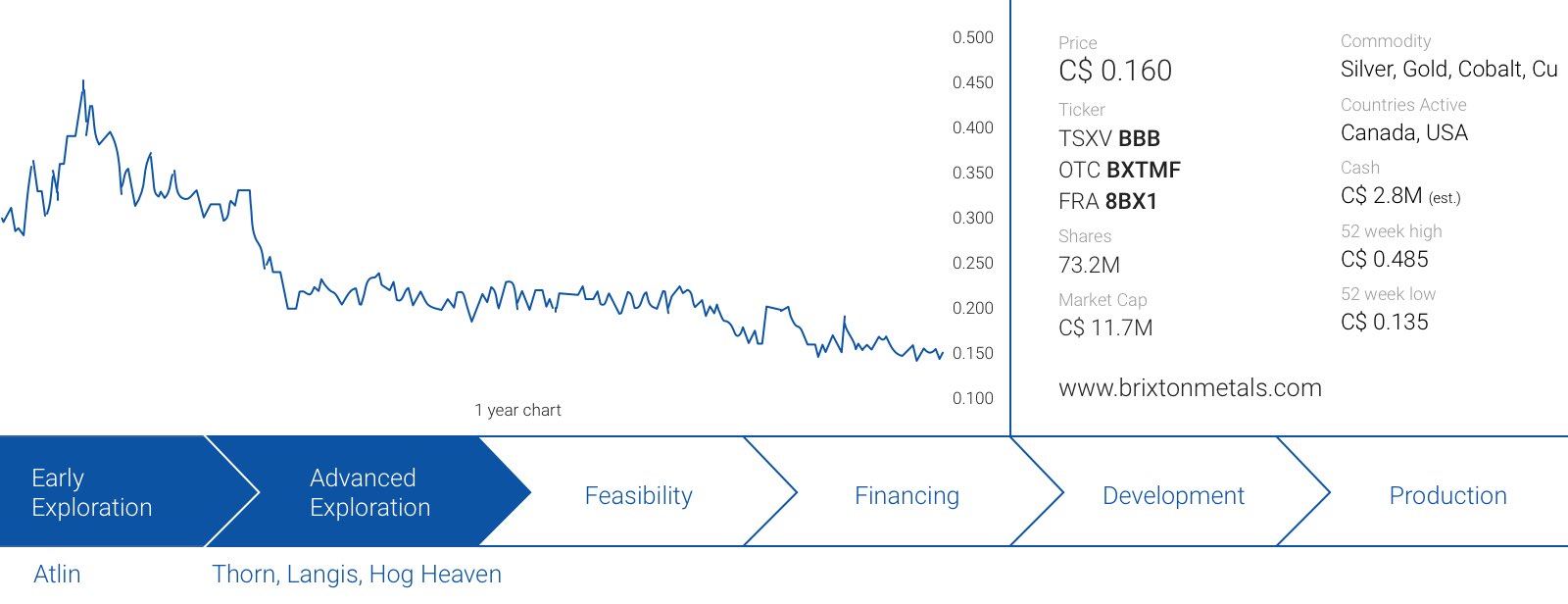 Could you review 2018 for us? What did you work on, and what did the company achieve in the past 12 months?
Could you review 2018 for us? What did you work on, and what did the company achieve in the past 12 months?
In 2018, Brixton was active on all four of its wholly-owned projects. We spent about $4M in the ground across our projects with a decreasing spend starting from Langis, Hog Heaven, Atlin Goldfields and Thorn. The Brixton team grew to twelve (mostly geologists) and strengthened its Board by adding a new Board of Director’s member, mine builder Randall Thompson.
For 2019 Brixton plans to focus on the Atlin Goldfields project and seek JV partners of its other projects if an attractive deal can be reached. However, the wholly owned assets have low to no holding costs and are drill ready with major upside potential so the company is not in a desperate situation to do just any deal.
Brixton conducted the most work at its Langis and Hudson Bay silver-cobalt properties in Cobalt, Ontario. The program exceeded its original objective, which was to drill in and around the historical past producing mine workings to test for high grade silver-cobalt mineralization as an extension of the workings. Several intercepts of multi-kilogram silver and multiple percent cobalt were encountered like 6m of 4719 g/t silver plus 0.33% cobalt and one hole retuned 3.55% cobalt over 1 meter.
In addition, while drilling for cobalt-silver, Brixton discovered a diamond bearing kimberlite zone (Several kimberlites are known to occur in the region). Since this unique kimberlite discovery, Brixton has drilled 11 (100-200m deep) holes hitting kimberlite in 10 of the 11 holes over a 20 hectare area, so we are pretty excited about this. The kimberlite material is currently being processed and results shall be released upon receipt which will likely take some time given the large volume of material.
At Brixton’s Hog Heaven silver-gold-copper project in NW Montana, we completed the historical assay data entry of 57,498 meters of drilling from 722 drill holes and built our 3D model. Brixton completed 724 line kilometers of VTEM Plus and 60 square kilometers of LiDAR. Through this review process we identified some of the previous holes encountered high grades gold and copper in additional to the silver. As an example: hole AFR-79-5 intersected 18.29m of 4.46% Cu, 4.51 g/t Au, 745.71 Ag and hole AFR-81-38A intersected 67.06m of 2.65 g/t Au, 339.94 g/t Ag and base metals we not analyzed. And AWFR-79-33 returned 3.05m of 26.06 g/t Au, 265.71 Ag and base metals were not analyzed. The project is permitted and drill ready. The Company is seeking a JV partners to advance the project. A historical non-Ni-43-101 compliant resource estimates sits at about 47Moz Ag and 0.23Moz Au and base metals were discounted.
At our Atlin gold project in Atlin, BC, Brixton consolidated the camp (12 deals over 2 years) and now controls 1004 square kilometers of district-scale, Barkerville-style land package. The project is road accessible with the potential to drill year round. During 2018 Brixton collected about 2500 soil samples, conducted geological mapping and re-logged core and are currently working up drill targets for 2019. There are 4 known prospects (Yellowjacket, Imperial, LD and Pictou) that we plan to drill test in 2019.
The Yellowjacket zone has a historic non-compliant-NI-43-101 estimate of 150,000oz Au at about 10 g/t Au. The best historic drill hole at the Yellowjacket zone was 5.5m of 509 g/t Au (16oz/t Au). The Imperial vein which is near the Yellowjacket zone was mined near surface (245 tons at grades between 5 and 14 g/t Au). The LD showing returned up to 293 g/t Au for Brixton in 2017 and historical trenching returned up to 330 g/t Au and limited drilled returned up to 3m of 9.4 g/t Au. The Pictou showing returned 10 g/t Au from a one ton bulk sample, 14 g/t over 2m from trenching and grab samples up to 52 g/t Au. During the 2018 program a large gold-in-soil anomaly was identified at the eastern portion of the property which will be followed up on during 2019. Drilling is planned for early May 2019 at the Atlin project.
At Brixton’s Thorn project in the Golden Triangle of BC, in collaboration with the Mineral Deposit Research Unit and porphyry specialist, Brock Riedell, we completed a program of core re-logging, geological mapping and sample collection for whole rock lithogeochemical analysis combined with short-wave infrared spectroscopy (SWIR). This is a cost-effective method to vector for copper-gold porphyry targets. Final results are pending.
What will 2019 bring? What will you be working on and what budget do you have in mind?
In 2019, Brixton plans to focus the majority of its resources on its high-grade Atlin Goldfields project. Past results of 5.5m of 509 g/t (16 oz/t) gold have been drilled near surface, and we feel this will prove to be the greatest value driver for the company. The market is very hungry for new discoveries, and the share price of companies announcing high-grade discoveries did very well this year.
The project is near the town of Atlin with road access, has low-cost drilling, and is in a very stable jurisdiction. We draw a strong comparison between Atlin and the historic Barkerville gold camp which now has 1.6Moz gold in the M&I and 2.1Moz Au in the Inferred categories.
We are planning to enter 2019 with a drilling budget of $2.5-$3M. This will give Brixton enough horsepower to drill our intended targets, develop new targets and with the potential for new discoveries as well. One of the objectives we have set for ourselves at Atlin is to sort out the structural controls for the gold mineralization; we are looking to “crack the code” on the geology.
What’s your near-term and longer-term outlook for your main commodity?
While the Company does have some multi-commodities optionality in its portfolio, like diamonds, silver and copper. We believe that many factors are contributing to a positive near-term outlook for gold.
Political instability and a falling US dollar should lead to a favorable gold market in the short to medium-term. Major producers are in search of quality projects in friendly jurisdictions and companies like Brixton Metals with wholly-owned projects such as these will be in an advantageous position. If you can develop a high grade gold resource in a place like Canada, you will not only have lots of potential buyers but you will garner a premium price for the asset.

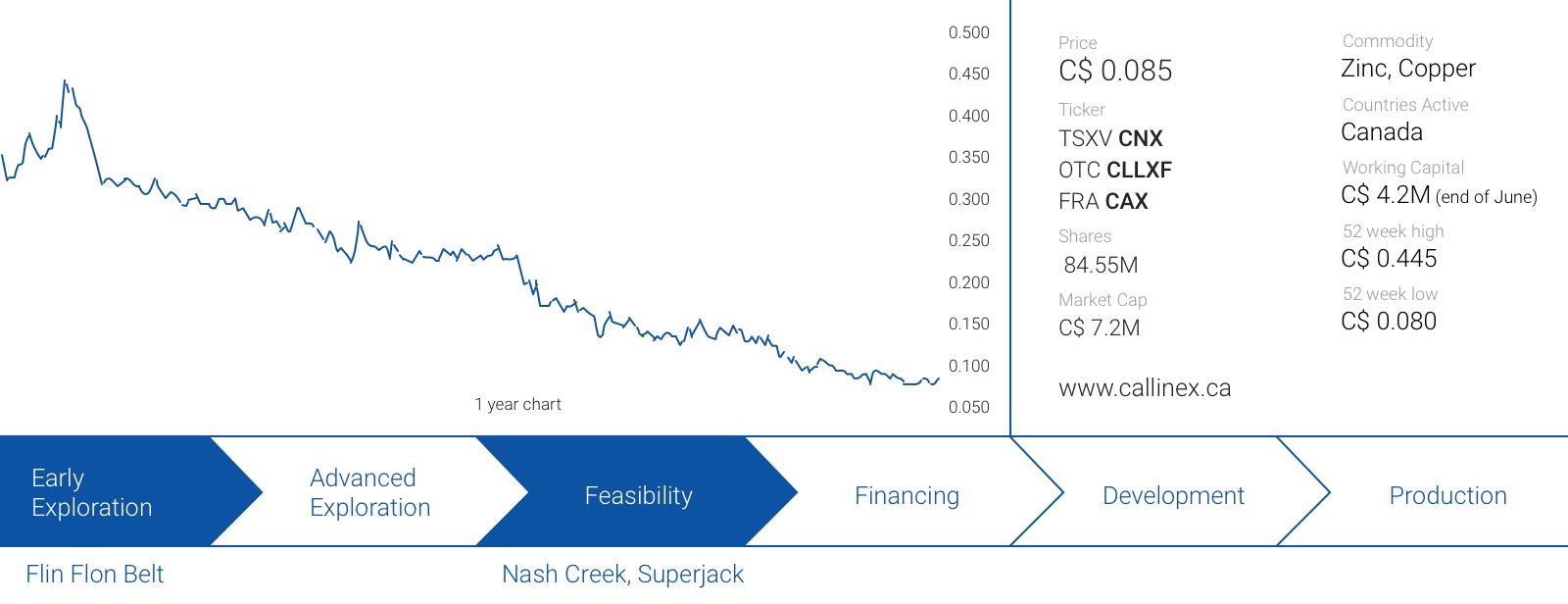
Callinex Mines (CNX.V) aggressively advanced the Nash Creek zinc project in New Brunswick this year. A resource update in April was used to determine the economics of the project in a Preliminary Economic Assessment in May which provided the market with a first look at the numbers. Exploration continued throughout the year as Callinex is trying to expand the resource at Nash Creek which will allow it to further optimize the mine plan to improve the economics.
Could you review 2018 for us? What did you work on, and what did the company achieve in the past 12 months?
Callinex had a busy year in 2018 with the most significant developments including an updated resource estimate and maiden Preliminary Economic Assessment at our Nash Creek Project located in the Bathurst Mining District of New Brunswick.
The updated resource at Nash Creek now hosts a near-surface Indicated mineral resource totaling 13.6 Mt averaging 3.2% Zn Eq. (2.7% Zn, 0.6% Pb and 17.8 g/t Ag) containing 963 million pounds of zinc equivalent mineralization and an Inferred mineral resource totaling 5.9 Mt averaging 3.1% Zn Eq. (2.7% Zn, 0.5% Pb and 14.0 g/t Ag) containing 407 million pounds of zinc equivalent mineralization.
Based on a very successful initial drill program in the second half of 2017, the Company efforts led to an increase in Indicated zinc equivalent pounds by 74% and Inferred zinc equivalent pounds by 385%. The ability to rapidly expand the deposit, and with drilling costs that averaged less than $75 per meter, underscores the exploration potential of the deposit.
With an updated resource in hand, our next focus was to demonstrate the economic potential of the project which we felt the market was underappreciating. As more than 80% of all zinc mines are underground there is generally a misunderstanding of what sort of grades make sense for an open pit zinc mine. The maiden PEA outlined attractive economics over a ten-year mine plan with an after-tax internal rate of return of 25%, NPV8% of C$128 million and highlighted several intriguing opportunities to further enhance the economic potential.
Importantly, the PEA outlined an operating margin of over 60% indicating that the ability to further expand mineral resources at comparable grades and extending the life of mine is likely to materially improve the economics further. This scenario is readily achievable given the cost-effective and timely exploration success we have achieved to-date and the deposit remains open in several directions. Nearly all previous drilling at the project has been limited to the immediate vicinity of the deposit so the upside potential to discovery additional deposits throughout the district-scale project is compelling.
These achievements in 2018 highlight the exciting growth potential of our flagship Nash Creek Project and demonstrates the ability of our team to acquire, explore and develop assets on accretive terms for our shareholders.
What will 2019 bring? What will you be working on and what budget do you have in mind?
In 2019 we are looking to be extremely efficient with capital allocation decisions given current market conditions. Early in 2018 we completed a raise at C$0.40 to fund a two-year exploration program and the Company is in strong financial shape to avoid dilution within the current market environment while also fundamentally advance our assets further through exploration.
Our main objective in 2019 is to test the district-scale potential of the Nash Creek Project where only 2 km of a 20 km long trend has been systematically tested. Through our exploration efforts in 2017 and 2018 it has become clear that the use of Induced Polarization surveys (IP) is the most effective method to explore the project. In late-2018, we made a major investment to complete a district-scale ground survey that fully covers the 20 km long trend with several high-grade mineral occurrences. The survey, which is still ongoing, spans more than 170 line kilometres and is designed to achieve significant depth penetration.
We are excited to complete this IP program and anticipate several targets will be drill-tested in 2019. With nearly all IP targets that have been drilled by the Company explained by mineralization or alteration associated with mineralization, this is a tool that could allow for rapid exploration success with a significant drill campaign that has been allocated as part of a fully-funded exploration program.
Additionally, we are also looking closely at completing an IP survey at our Pine Bay Project in the Flin Flon Mining District of Manitoba in early-2019. The Pine Bay Project is one of the most exciting projects in the Flin Flon district as high-grade mineralization is associated with arguably the largest alteration zone within the camp and is located close to HudBay’s 777 Mine. Typically, there is a correlation between the size of an alteration zone and the size of VMS deposit it is associated with.
Our previous drilling at the project highlighted this potential with a discovery hole that intersected 10.3m of 6.0% Zn, 1.8 g/t Au, 60.4 g/t Ag, 0.7% Cu and 0.4% Pb; however, the pyrite-rich mineralization is lowly conductive and traditional borehole electromagnetic surveys appear to be ineffective. An IP survey, which has never been completed before on the project, is typically very good at identifying lowly conductive pyrite and we believe a survey could be a low-risk/high upside opportunity to unlock the potential of the project.
What’s your near-term and longer-term outlook for your main commodity?
Our primary commodity is zinc, although gold, silver, copper and lead are common by-products. We view the near-term outlook for zinc as being relatively rangebound until the United States and China conclude their ongoing trade negotiations, which we expect in 2019. China is the world’s largest consumer of zinc, along with other base metals, so the impacts of tariffs and negotiating rhetoric has negatively impacted sentiment in the market overall.
The reality is that the zinc market remains in a supply-demand deficit today and inventory levels have declined to critically low levels based on this supply deficit. In fact, inventory levels are even lower than in early-2018 when zinc was trading around $1.60 per pound compared to a current price of around $1.20 per pound. We believe long-term the zinc market will remain strong as there is limited new supply projected to come online and most of the projected increase in supply is sourced from existing mines, which could be unstainable longer term at current price levels.
Zinc is typically a challenging commodity to explore for as it does not provide an easy geophysical target for drill targeting and with nearly all mines being underground, drill holes have to be completed to deeper depths and underground development requires more capital and planning than a typical open pit operation which is the norm for other base metals.
These are all factors that underpin the zinc market longer-term compared to other commodities. We believe our Nash Creek Project is a great way for our shareholders to have exposure to the zinc market with its strategic location as an open pit project within a major Canadian mining jurisdiction, attractive economics and district-scale exploration potential that we look forward to unlocking in 2019.
Contact Gold (C.V) has made a lot of progress on its Pony Creek gold project in Nevada. The company spent millions of dollars on drilling the property and has now confirmed there seems to be a widespread ‘blanket’ of gold mineralization that seems to be the extension of the gold zones on the neighboring properties owned by Gold Standard Ventures (GSV.TO, GSV).
We talked to Chris Pennimpede who takes care of Contact Gold’s Corporate Development to discuss the achievements of Contact Gold and his expectations for the gold sector.
Could you review 2018 for us? What did you work on, and what did the company achieve in the past 12 months?
2018 was a year of discovery for Contact Gold. The company’s two most significant accomplishments were: expanding the oxide gold footprint (at 100 gram meters) through step-out drilling at the Bowl Zone; proving the historic resource could be expanded, and the subsequent development and discovery of the West Zone.
The West Zone started the year as a 2km long gold-in-soil anomaly. It’s very unusual for a soil anomaly to deliver across its entire length, but Contact has now identified more than 2.3 km of oxide gold extending from surface in every drill hole at the West Zone; including the discovery hole (PC18-18)33m @ 0.42 g/t Au, followed by (PC18-22) 10m @ 0.7 g/t Au in late summer. The final holes from the West Zone, released in late November (PC18-49 to 51), were particularly interesting as they were thick (93 @ 0.33 g/t Au) oxide gold intercepts from surface at the northern most section of the soil anomaly.
The next steps for Contact at the West Zone will be going back to increase the drill density and hopefully find higher grade pods that are typical in these Carlin-type gold systems. By succeeding in making new discoveries at Pony Creek, Contact is now in a position to further advance these new discoveries to deposits in 2019.
What will 2019 bring? What will you be working on and what budget do you have in mind?
2019 will be a very busy and critical year for Contact Gold. We will be focused on aggressively pushing forward exploration and drilling at Pony Creek. The successes we’ve had – identifying new, large Carlin-type gold systems over the last 1.5 years – mean that we now have to focus on drill density to prove up these discoveries into new gold resources on the property.
To accomplish this, we have to look to increasing drill density at our recent discoveries, and testing virgin targets as well. The drilling budget for 2019 will be determined early in the new year once all the results from this year have been received and reviewed.
What’s your near-term and longer-term outlook for your main commodity?
The current economic climate for junior gold explorers certainly illustrates the need for projects to be in safe, mining-friendly, and low-cost jurisdictions where miners can operate and make a profit at $1100-1200 gold.
When we started Contact Gold we were focused on “Tier-1” jurisdictions (Nevada, Ontario, Quebec). Tier-1 jurisdictions survive downturns and depressed metal prices because the infrastructure is already in place, and the regulatory framework offer a safe, reliable and streamlined path to production. During the last downturn all gold majors focused in on their key low-cost producing mines/jurisdictions and Nevada proved to be critically important for Newmont Mining (NEM.TO, NEM), Barrick Gold (ABX, ABX.TO) and others.
Additionally, all of these producers are now seeing their production profiles decline, with some of them steeply declining. They will need to add deposits in these Tier-1 jurisdictions, which puts Contact in a good position. Overall, all of these factors should be good for gold.
The gold price (and the exploration industry) slowly increased from 2002 – 2008 after the tech bubble. I think the expectation that gold would go right back to the frothy 2011 $1,900/oz level was unrealistic coming out of the downturn in 2016. I would prefer to see a slow, steady increase in gold price with some healthy dips coinciding with the bursting of the “Everything Bubble” and further decline of the FAANG stocks.
These events are already starting to take place and I expect gold will be seen as a safe haven as investors look for security. The gold price should benefit from market turmoil and we expect gold prices to incrementally rise over the coming years.

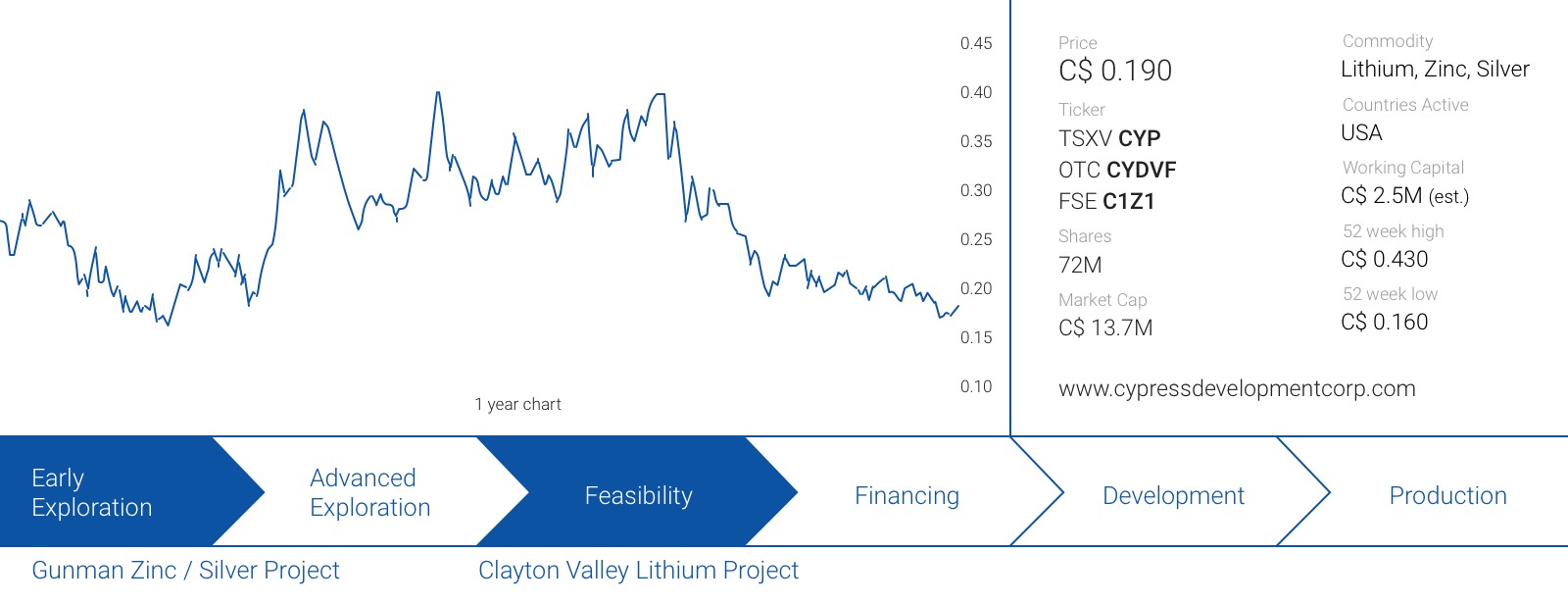
Cypress Development (CYP.V) has also been hit by the fears of an oversupply on the lithium market, but as Orocobre (ORE.AX, ORL.TO) just announced it sold lithium carbonate at a price of in excess of $10,500/t, these fears may be overblown. The weaker share price does not reflect the excellent progress made by the company this year as it completed a maiden resource estimate and a Preliminary Economic Assessment. In our previous report (see here), we also discussed the merits of the project at a lower lithium price, and the conclusion was clear: even at a lithium carbonate price of $9,000/t (25% lower than the current price), Cypress’ Clayton Valley Lithium project would still be economic with an after-tax NPV8% of approximately US$600M.
Could you review 2018 for us? What did you work on, and what did the company achieve in the past 12 months?
Cypress advanced the Clayton Valley Lithium project in 2018 as the company published a maiden resource estimate in Q2 followed by a Preliminary Economic Assessment in Q3. The PEA suggested the Clayton Valley project could have robust economics with an after-tax NPV8% of nearly US$1.45B and an Internal Rate of Return of ~33% using a Lithium Carbonate price of US$13,000/t. The mine plan in the PEA calls for an annual production rate of just over 24,000 tonnes of lithium carbonate over a 40-year mine life. The company expects to follow up on these scoping level economics in an upcoming prefeasibility study.
The company recently raised C$2.0M at C$0.22/share (which is more than 20% higher than the current share price) to continue to fund project next steps including further metallurgical study, infill drilling, and a prefeasibility study in the first half of next year.
What will 2019 bring? What will you be working on and what budget do you have in mind?
The company is currently conducting follow-up metallurgical test work to optimize the recovery of lithium from the mineralized rock. Cypress expects to publish results of this test work early in the new year and believes this could be an important milestone as a detailed flow sheet will also help in discussions with potential partners and offtake parties.
2019 will be a busy year for Cypress, as the company expects to apply the metallurgical test work related to the economics of the project in the publication of a pre-feasibility study in the first half of 2019. The PFS will also include the results of an up to 1,500 meter infill drill program (which should start early in 2019).
What’s your near-term and longer-term outlook for your main commodity?
The sentiment surrounding the lithium sector has been relatively weak over the past few quarters. Although the market was expecting the lithium sector to go into an oversupply-situation, lithium prices have remained strong owing to solid demand from battery manufacturers. With a lithium carbonate price of in excess of US$10,000/t and lower fears for an oversupplied lithium market, we would expect the appetite for lithium companies and projects to come back in 2019.


It looks like 2018 will be another excellent year for Elysee Development Corp. (ELC.V). The net income in the first nine months of the year already came in at C$1.2M (C$0.06/share) which is an excellent achievement for a company whose share price is trading in the mid-30’s. Elysee also raised C$1.7M in a no-warrant financing at C$0.35 which has helped to boost the current cash position to approximately C$4M.
Elysee’s share buyback program is still ongoing and Elysee has been repurchasing stock below the most recent issue price which further enhances the NAV/share, which stood at C$0.56/share as of the end of August. The company recently announced a (relatively) large investment in US Vanadium LLC where it acquired a strategic 19% stake. We had a chat with Guido Cloetens, Chairman and CEO of Elysee Development.
Could you review 2018 for us? What did you work on, and what did the company achieve in the past 12 months?
Despite the volatility Elysee managed to outperform the stock markets and the mining sector in general, and we are obviously very happy with this performance.
We continued to focus on our core positions like Largo Resources (LGO.TO) and Kirkland Lake Gold (KL.TO, KL). We also liquidated many smaller non-performing investments to boost our cash position, enabling us to take advantage of investment opportunities. We have been cautious this year and have made several investments in private convertible debentures which has the advantage that it reduces volatility, provides a fixed income but still has exposure to the equity side.
What will 2019 bring? What will you be working on and what budget do you have in mind?
We recently announced an important investment in US Vanadium LLC (USV) which is a private venture. USV through its contacts is able to secure/buy vanadium concentrates at a big discount and processes them into refined vanadium products such as V2O5, V2O3 etc.
This investment is being funded mainly by the partial sale of our very successful investment in Largo Resources. The idea is to reduce our exposure to the volatile price of Vanadium but still profit from the increasing demand for the metal.
What’s your near-term and longer-term outlook for your main commodity?
Despite the successful inroads into Vanadium and other commodities our main focus is still on Gold and Silver. We believe that precious metals will perform well in 2019 now that equity markets in general are under pressure due to rising interest rates, geopolitical and trade tensions and a falling consumer confidence in different parts of the world.
I don’t like setting specific targets for the price of gold or silver. I believe it is much more important to seek out mining companies that are blessed with a management with a proven track record. One should approach mining companies like other companies. A good product by itself doesn’t suffice, one has to be able to produce it and sell it in the most profitable way.
Blaine Monaghan recently moved from a Vice-President position at Allegiant Gold (AUAU.V) to become CEO at Fremont Gold (FRE.V), a gold exploration company exploring the tenements directly adjacent to McEwen Mining’s (MUX.TO, MUX) Gold Bar development project in Nevada. Monaghan didn’t waste any time and recently closed an oversubscribed placement, raising C$1.23M which will go a long way towards a new drill program at Gold Bar and Gold Canyon in 2019.
Could you review 2018 for us? What did you work on, and what did the company achieve in the past 12 months?
On the exploration and the corporate front, 2018 was a busy year for us. On the exploration front, we drilled both Gold Bar and Gold Canyon, with good results. We also carried out some earlier stage exploration work at North Carlin, which identified some excellent drill targets. On the corporate side, I was named the new CEO of Fremont Gold, replacing Dennis Moore, who remains as President, so he can focus on what he does best, which is making new discoveries.
We’ve also had great success in building out our advisory board. We named Derek White to it this past summer and we recently appointed Douglas Hurst, who was the executive chairman of Northern Empire when it was acquired by Coeur Mining. In addition, we just closed an over subscribed financing. No small feat in the current market environment. I believe this speaks to the quality of our team and of our projects.
What will 2019 bring? What will you be working on and what budget do you have in mind?
We are currently permitting Gold Bar and Gold Canyon for another round of drilling and expect to be drilling early in 2019. However, unlike last year’s drilling programs, this program will be focused on finding additional mineralization along strike and at depth.
At Gold Bar, we believe we may have discovered a possible extension to the historic Gold Bar mine. We’ll be testing a coincident gold and mercury soil anomaly to the south east of the historic Gold Bar mine in an area that hasn’t seen any drilling. We’ll be testing this anomaly with four 300-metre holes.
At Gold Canyon, we are looking to further define a mineralized horizon that we intercepted in last year’s program. We plan to drill four 200-metre holes at Gold Canyon. I’d also like to drill test North Carlin sometime in the second half of 2019, so we are gearing up for a very busy 2019 on several fronts.
What’s your near-term and longer-term outlook for your main commodity?
I think there are a lot of reasons to be bullish about gold. However, in the short term, I believe a weaker US dollar will lead to an improved gold environment. It would appear that the Fed has blinked and is no longer as hawkish as it once was regarding the pace of rate increases.

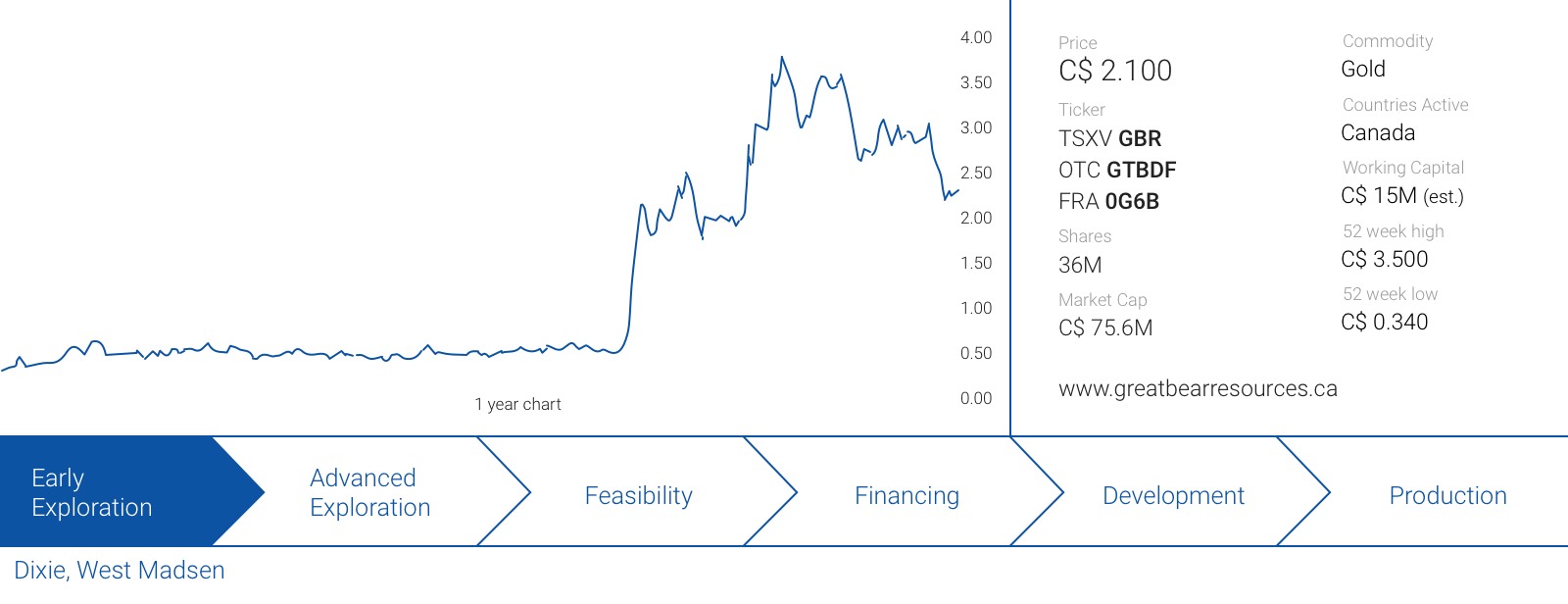
Great Bear Resources (GBR.V) had an amazing year as it started the year at around C$0.40/share but reached a 52-week high of C$3.50 on the back of what appears to be a mega-discovery in Ontario’s Red Lake gold district. GBR intersected 7 meters at almost 69 g/t gold as well as 16.35 meters at 26.91 g/t. These weren’t ‘lucky shots’ as Great Bear’s more recent drill results confirmed the widespread presence of high-grade gold mineralization, which it has now chased to a depth of up to 365 meters.
Great Bear found a strategic investor in McEwen Mining (MUX.TO, MUX) and Rob McEwen himself, and is ending the year with almost C$15M in cash after completing a C$3.5M flow-through financing in November. Ironically, the company’s cash position per share is now almost as high as the share price at the start of this year.
Great Bear is more than fully funded for its ongoing 30,000-meter drill program, and we should have a much better idea about the scope of the project once the results of this drill program will be analyzed. We sat down with a very happy Chris Taylor who answered our three questions.
Could you review 2018 for us? What did you work on, and what did the company achieve in the past 12 months?
Great Bear entered 2018 with an approximately C$10M market cap, and trading at about C$0.39. We are currently finishing 2018 with a market cap of approximately C$75M and trading at about C$2, providing a 7x to 8x return for our investors.
During the year we drilled new high-grade gold discoveries at our Dixie property in Red Lake, Ontario. The market responded positively to these discoveries because the project is located beside a paved highway only 15 minutes drive from other major gold mines, and the gold we found extends right to surface. The lack of external royalties, and the clean 100% ownership of the project enhanced the value of these discoveries and its infrastructure advantages.
Prior to 2018 we had completed a modest 8 hole, 1,000m drill program at our Dixie project. The success of this program, which included a hit of 16 g/t Au over 10 m on the Dixie North Limb Zone, allowed the Company to slowly expand its operations in a careful, non-dilutive manner.
What followed was a 3,000m program which we expanded to 10,000m. As this program was drawing to a close we made a new high-grade gold discovery that included holes grading 7m of 68 g/t Au and 19m of 26 g/t Au at less than 100m depth in a “Hinge Zone” and “South Limb Zone” that had not been the focus of historical work programs. Follow-up drilling has continued to find gold across a wider area, and has followed up with Hinge Zone drilling that included 3.65m of 27 g/t Au extending continuous gold mineralization from surface to 200m depth, and showing great depth extent for this new discovery.
In short, the gold zones at our Dixie property appear to match the size, grade and potential depth extent of many of the gold zones that have been, and are currently being mined by larger companies in the district, including Goldcorp (G.TO, GG).
The Company has also been successful raising money to fund our work. Within 48 hours of the release of the first Hinge Zone results, the Company had announced a $10 million financing including almost $6 million from Rob McEwen. Rob McEwen previously grew Goldcorp to a major global gold producer based on the success of his High Grade Zone discovery at the main Red Lake Gold Mine, and when he saw similar results being issued by Great Bear, but at much shallower depths, he was quick to grasp the potential significance, and was equally quick to become Great Bear’s largest shareholder.
We have subsequently continued to strengthen our treasury in a way that is very respectful of shareholder dilution, with a further $3.5 million bought deal financing with Cormark Securities, which required issuance of only 1M shares.
Ending the year with approximately $15 million in cash, we enter 2019 fully funded for the next two years of work in Red Lake and a 30,000m drill program that will see a constant flow of results over the coming year.
What will 2019 bring? What will you be working on and what budget do you have in mind?
We begin 2019 at the early stages of a 30,000m, C$5.5M drill program that will focus on expanding the Dixie Limb Zone where we made our first high-grade discovery, and significant follow-up to the high-grade discoveries we have drilled at the Hinge Zone and the South Limb Zone. We also expect to add a second drill rig that will allow us to more rapidly drill test our known zones, and drill test new regional targets on our extensive and highly prospective land package.
We do not anticipate the need to finance the Company again in 2019 and have sufficient funds on hand to drill up to 80,000 meters without seeking additional funding from the market.
What’s your near-term and longer-term outlook for your main commodity?
One of the beauties of discovery is that price moves in the underlying commodity price are less important than they are to that of a producer. That being said, we are cognisant that a rising gold price will provide investment support to the sector and make it easier to raise money when we eventually do need to proceed to more advanced exploration programs.
We think the price movements in gold will likely be rangebound at least during the first half of the year as the US interest rate cycle continues to move upwards with a number of additional modest moves. By Q3/4 we could see a more significant move in gold as the rate cycle runs its course. Despite the impression that the gold market has appeared very soft this year, it is improving in Q4 and the gold price is only off slightly from January of 2018. In many ways it has demonstrated its flight to safety status as a preserver of wealth against the increased volatility in other sectors and broader markets in general.
Of additional interest, we have heard from many large market participants that the general lack of interest in resource companies that has suppressed junior exploration company valuations for the better part of a decade is now wearing off. Investment funds for example are seeking to replace positions in aging tech stocks and other recent underperformers, and are looking at resources where “what is old is becoming new again”. This could materially benefit share performance in our sector through 2019.
Improving gold prices and investor sector rotation into commodities are both positive forces that, when combined with our expanding new gold discoveries at Dixie, should enhance an already winning formula for Great Bear.

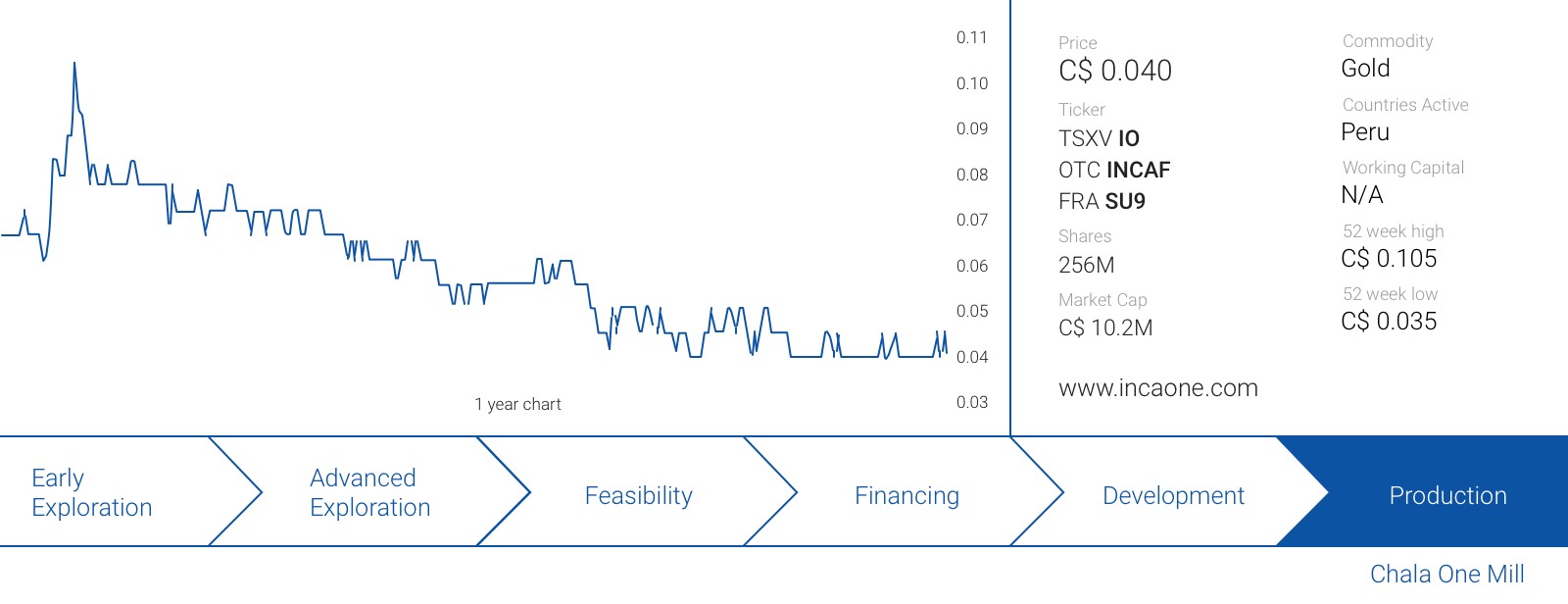
Inca One Gold (IO.V) had a very busy year as the company is ramping up the gold production in Peru after a game-changing deal whereby it acquired the 90.14% stake in the Koricancha mill from Equinox Gold (EQX.V).
The acquisition of the mill increases Inca One’s existing throughput from 100 tonnes per day to 450 tonnes per day, creating the economies of scale the company has been looking for. This had an immediate impact as Inca One has been consistently producing 2,600-3,000 ounces of gold per month lately, and we expect a smooth ramp up to a steady rate of just over 3,000 oz/month throughout 2019. Inca One expected to generate an EBITDA of $100-150/oz a few years back, which would result in a consolidated EBITDA of $3.5-5.5M. These are just our own estimates, and we would expect Inca One to provide some sort of guidance early in the new calendar year.
Could you review 2018 for us? What did you work on, and what did the company achieve in the past 12 months?
At the beginning of this year, we overhauled our financial structure to create more flexibility. We completed a C$2M financing in February which allowed us to achieve full production at our Chala One plant, while we also restructured C$2.4M in short-term debt. 1/3rd was converted into stock while the remaining 2/3rd of the debt was extended for an additional three years.
Additionally, we were able to secure an Advance Payment facility with Ocean Partners which markets our gold output, and this provided an additional C$0.5M in available working capital.
These transactions have helped us to convince investors we were a good fit to acquire the Koricancha plant from Equinox Gold, and this important transaction closed in the third quarter of this year. Economies of scale are important in this sector, and we think we can generate synergy benefits to the tune of US$2M per year after combining the Koricancha and Chala One operations under one management team.
What will 2019 bring? What will you be working on and what budget do you have in mind?
Now we have secured our throughput increase, our main focus will now be on growing our mineral purchases team to continue to establish Inca One as a serious purchaser of the ore of artisanal miners. It’s all about customer loyalty and brand building, and these two elements are an important part of running the business in Peru: we think the best branded companies in this space will never run out of ore supply.
We will also continue to look for cost reductions where possible, but we have no plans to stop growing anytime soon. We continue to look for accretive opportunities to both add mineral supply as well as additional processing capacity.
What’s your near-term and longer-term outlook for your main commodity?
Given the money supply creation since 2008 the prices of precious metals should be much higher. Pick a number. We have all heard the wide range of predictions on what the gold price should be. Also, we still have not seen the real impact of true inflation. This I believe in the long term will end up being reflected in the gold price.
Integra Resources (ITR.V) had a very busy 2018 as it started a 20,000 meter drill program on the DeLamar and Florida Mountain projects right after announcing a maiden resource estimate of 871,000 gold-equivalent ounces at Florida Mountain. This pushed the combined resource to 3.54 million gold-equivalent ounces (2.27Moz gold and 108.5 million ounces silver) at an average grade of 0.71 g/t AuEq.
And the assay results from this drill program have been impressive. The company has been stepping out from the currently known inferred resource estimate and continues to hit gold mineralization, paving the way to lift the gold-equivalent resource to 5 million ounces. CEO George Salamis answered the same three questions.
Could you review 2018 for us? What did you work on, and what did the company achieve in the past 12 months?
The last 12 months were a whirlwind for Integra. Since November 2017, Integra acquired the past producing DeLamar and Florida Mountain deposits, released two NI-43-101 Resource Estimates outlining 3.5 million ounces AuEq, drilled 20,000 meters on the project (the first major drill program at DeLamar since the 1990s), significantly increased our land package to include more than 6 km of highly prospective ground, and identified multiple new targets and zones of mineralization below and around DeLamar.
Perhaps one of the most important milestones in the last year was the discovery of Sullivan Gulch. Located on the edge of the existing resource envelope at the DeLamar Deposit, Sullivan Gulch returned a strong IP anomaly that when drilled revealed significant, undiscovered gold mineralization. Over a 500m strike length, Integra drilled fences spaced at 100 m that returned gold over widths of 100 m and 200 m at 1.25+ to 2.0+ g/t AuEq. Sullivan Gulch, not explored by previous operators, has the potential to grow the resource substantially.
The drill bit and field reconnaissance also identified high-grade targets west of DeLamar, including Henrietta (1,080.00 g/t Ag over 4.57 m (13.00 g/t AuEq over 4.57 m)) and Milestone (to be drilled in early 2019).
What will 2019 bring? What will you be working on and what budget do you have in mind?
After our recent financing, we plan on hitting the ground running in 2019. The drills will take a short holiday hiatus before ramping up again in mid-January and peaking during the summer. While budgets are still being finalized, we expect to drill another 20,000+ m at DeLamar in 2019. In addition to drilling Florida Mountain and DeLamar, we will also use the drill to test some high-grade targets on recently staked, highly prospective ground near DeLamar.
In addition to the drill program, Integra also plans to update the resource estimate on the project in Q1 2019 and feed that into a Preliminary Economic Assessment in H12019. This PEA will be an option study on the project, outlining multiple processing scenarios at DeLamar – heap leach, heap leach plus mill, mill as a standalone. Based on the 20 year history of milling at DeLamar, the Company knows how a mill works…well. To understand how mineralized material would heap leach, we’ve engaged McClelland Labs in Reno to undertake metallurgical testing on core samples from all around the DeLamar and Florida Mountain Deposits. This test work is already underway and will be completed in Q1 2019 as well.
What’s your near-term and longer-term outlook for gold?
Based on sector research, including research from major banks who are bullish on gold and commodities for the first time in years, it is hard not to get excited about the potential for a decent gold market. However, during the Integra Gold days, arguably some of the darkest days for the yellow metal, we stuck to the mantra, control what you can control.
At Integra Resources, we’ve stuck to that mantra. Integra can’t control the price of gold…but we can de-risk the project, grow the resource, and work with inputs to ensure the economics of this project work in an uncertain gold market. In our opinion, advancing the project is the only way to create greater value for our shareholder, both in the short and long term.

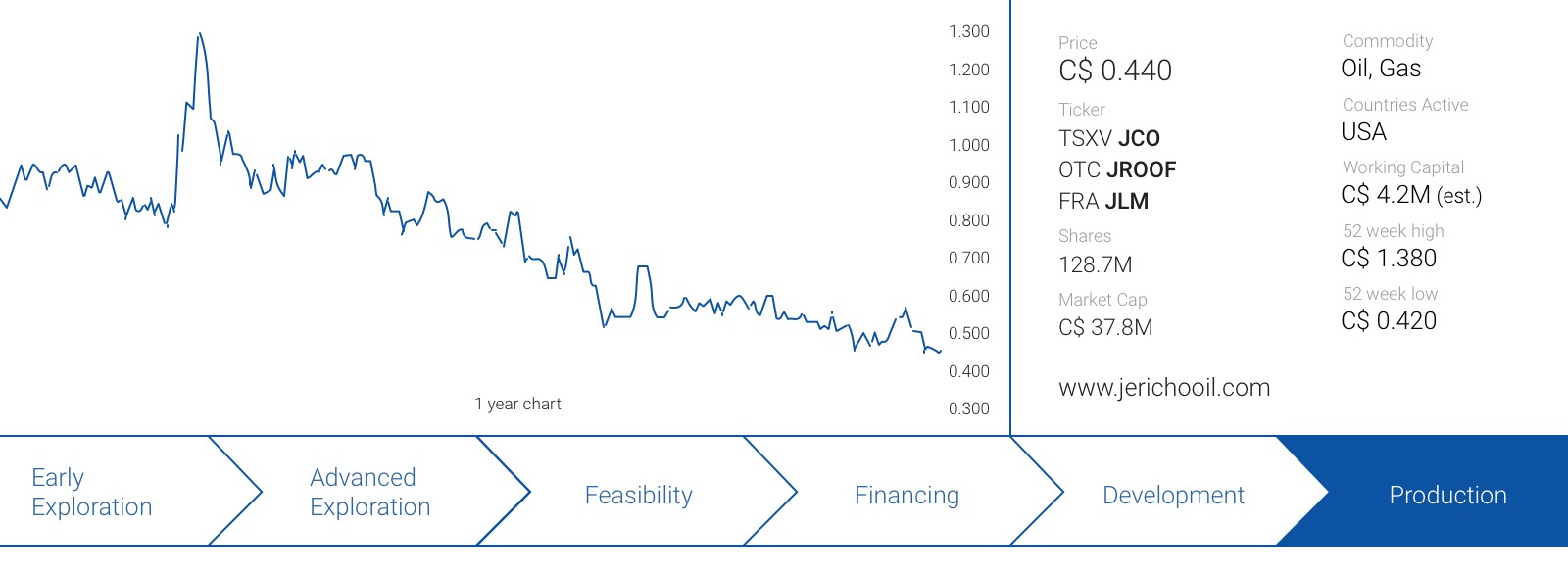
Jericho Oil (JCO.V) has made some major steps forward this year as the company elected to participate – through its 26.5% owned STACK JV – in the drilling of two wells in the Meramec formation (Wardroom and Valkyrie) as well as two wells in the Osage Formation (Trebuchet and Swordspear). Due to the minority working interest of the STACK JV in these wells and Jericho’s minority stake in the STACK JV, the net oil production attributable to Jericho Oil will be relatively small.
That being said, the drilling increases Jericho’s PUD reserves and provides extensive (technical) information gained from drilling these wells will prove to be invaluable for the STACK JV when it will start to drill more wells on its 16,000-acre STACK land package. The oil price has been very weak lately, but both Jericho and the STACK JV have healthy balance sheets that will help them to weather the current storm.
Could you review 2018 for us? What did you work on, and what did the company achieve in the past 12 months?
Jericho’s primary goal throughout 2018 was to build and subsequently prove up and develop our position in the STACK Play of Oklahoma, one of the lowest-cost, high-return U.S. shale basins driving long-term net asset value for our shareholders.
To that end, Jericho commenced 2018 with three transactions that allowed the Company to cost-effectively boost its strategic acreage position in the prolific STACK Play, with an interest in nearly 16,000 net acres surrounded by marque operators like Alta Mesa Resources (AMR) and ExxonMobil (XOM).
Once Jericho assembled its contiguous acreage the company set forth on a path to prove up its position through the drill-bit, targeting the principle formations of the 700 foot thick oil-bearing pay. Geographically and geologically, 2018 was a strong success in reaching our goal of de-risking our STACK resource base. We produced strong well results with significant longevity which has given the company great confidence in the entire aerial extent of our acreage position in addition to the deep inventory of future multi-zone development.
Inherent in these successes are the benefits to our shareholder base, which has seen strong production from our STACK play which should, in turn, result in strong growth in our year-end Proved Reserves compared to 2017. Ultimately, 2018 has been an extremely productive year, with clear goals, which has allowed our Company to have ever-increasing confidence in repeatable, multi-zone development of our STACK resource base which, over time, should benefit our shareholder base.
What will 2019 bring? What will you be working on and what budget do you have in mind?
While we have not finalized our 2019 capital budget, our preliminary plans dovetail nicely off our 2018 achievements. Our 2018 experiences, through drilling and participating in both target zone formation wells (the Meramec and Osage), have provided our STACK position the proper catalysts of data to leverage into the Company’s 2019 development program.
Overall, 2019 will see Jericho continue to prove up and exploit its STACK resource with year over year increases in well results, in addition to generating strong cash flows from its existing asset base across Oklahoma to fund much of our capital efficient development.
What’s your near-term and longer-term outlook for your main commodity?
We produce both crude oil and natural gas. Our expectations are for crude oil to remain in a solid average range between $55-70 per barrel with natural gas averaging around $3.00 per mcf. We feel that our organization and low-cost asset base is set up well to deliver shareholder returns in this price regime.

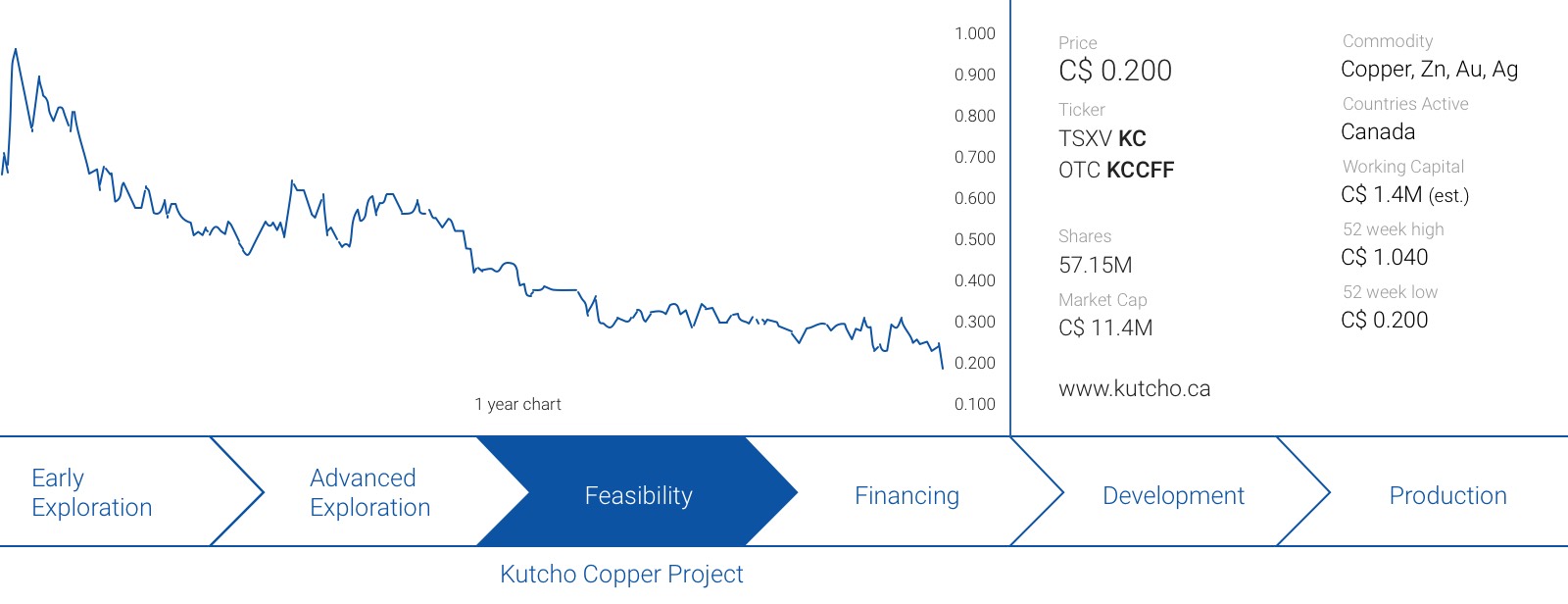
Kutcho Copper (KC.V) has been very active in 2018 as the company has spent approximately C$10M on exploration activities between May 1st and the end of October. Kutcho completed almost 11,000 meters of drilling during the 2018 field season and remains on track to complete a full feasibility study in the second quarter of 2019.
Most of the drilling was geotechnical drilling at Esso and the Main deposits, but the 3,850 meters that were completed as part of the resource infill and expansion drill program yielded some interesting results with high-grade copper values outside of the current resource outline. We sat down with Vince Sorace, President and CEO of Kutcho Copper.
Could you review 2018 for us? What did you work on, and what did the company achieve in the past 12 months?
We had a very busy 2018 as we aggressively explored our namesake Kutcho Copper project in British Columbia. We had a few clear goals in mind before the start of this drill program. A first goal was to convert some of the inferred resources (5.8 million tonnes at an average grade of approximately 1.8% CuEq of which 1Mt at 2.21% CuEq is located at the Main zone with an additional 4.8 million tonnes at 1.7% CuEq at the Sumac zone) into the measured and indicated categories, which would allow us to add additional tonnes to the mine plan.
So we started 2018 with a good game plan, and we feel the exploration plans have definitely added value to the project as a whole as we were able to confirm the grades in the existing resources but also successfully tested the rocks below the current resource outline. At Esso, for instance, we encountered 11.5 meters at 1.9% copper-equivalent, including a higher grade interval of 1.5 meters at 6.6% copper-equivalent in a new stringer zone outside of the resource envelope.
We also drilled some holes that confirmed the known mineralization at the deposits, and the core of those holes will now be used to further fine-tune our metallurgical test program, and we expect to see the results of the met work relatively soon.
On the financial front, we completed a C$4.14M flow-through offering in August when we issued 9.2 million FT shares at C$0.45 per share, but we also received two US$3.5M (C$4.5M) payments from Wheaton Precious Metals (WPM.TO, WPM) as part of our streaming agreement. Wheaton will provide US$65M in cash as part of a streaming agreement, but also provided C$24M in convertible debt and equity investments. We’re glad to have a strong partner as their commitment to wire us US$58M to be spent on development capital throughout the construction phase will be an important part of our financing mix.
What’s your near-term and longer-term outlook for your main commodity?
The copper price has been quite volatile this year as the price per pound remained firmly above US$3 in the first half of the year. Weakness on the metal markets throughout the summer (fueled by the trade wars and the lack of visibility of the demand from China), but the underlying fundamentals remain very strong.
The continuing ‘electrification revolution’ will keep the demand for copper at an elevated level, and the supply side may not be able to accommodate the demand. After all, even at $2.75 per pound, the incentive for copper companies to bring new projects online is pretty marginal given the expensive cost of capital and the regulatory hoops one has to jump through these days. That’s why we feel our high-grade polymetallic underground project is in an excellent position to be developed as part of the ‘supply solution’.
There have been a lot of new cobalt stories popping up in the past 18 months or so, but M2 Cobalt (MC.V) is the only company trying to go elephant hunting through grassroots exploration in Uganda. Following a sound exploration theory which expects the cobalt-rich mineralization from the DRC to extend onto the Ugandan territory, it acquired a dominating land position in the country.
Following an extensive sampling and trenching program, M2 Cobalt is currently drilling some high-priority prospects on its claims and the assay results should be out in the next few weeks or so. CEO Simon Clarke answered our questions.
Could you review 2018 for us? What did you work on, and what did the company achieve in the past 12 months?
M2 Cobalt had a strong year despite challenging stock market conditions in the second half of the year. We started the year with the acquisition of a very large land package of highly prospective acreage in Uganda and we raised $8.5 million on the back of that transaction. We have spent approximately $5M directly on our projects in Uganda to date and have discovered numerous, cobalt, copper and nickel targets across 3 different styles of mineralization. We are now in the process of conducting a small initial drill program to further test and progress 2-3 of our key initial targets.
Critically we have also cemented our position as first mover for cobalt in Uganda and we have built a strong local team headed by Dr. Jennifer Hinton who has been based in Uganda for 13 years and who is a key figure in the mining community locally. Through Jennifer and her team, we are very well positioned in the country. The new technologies we have introduced to the country have been very well received.
The geological potential of Uganda with the same underlying geology and many shared mineral trends as the DRC (where 70% of global cobalt production will originate this year) is, to my mind, now without question. Our goal very much remains to discover and develop world-class cobalt (and related minerals) assets with the potential for large scale production to help meet the looming supply shortages many commentators predict for the early 2020s.
What will 2019 bring? What will you be working on and what budget do you have in mind?
We will conclude our initial drill programs currently underway and our current plan is to commence resource drilling on at least one of our key targets with the goal of maiden resource numbers in H2 next year and moving into PEA phase thereafter. Our asset package is very large with large-scale potential and this also offers the potential to bring in appropriate partners as we advance our projects.
Budgets will depend on capital markets, but at this point we envisage at least a further $3-$5m in drilling next year with the potential for significantly higher drilling budgets. We will also look to launch geophysical and geochemical programs across the exploration licenses we acquired in our recent strategic asset acquisition.
What’s your near-term and longer-term outlook for your main commodity?
I believe there is a large disconnect between the huge surge in electric vehicle sales (especially with so many new models coming online from next year onwards) and the growth in the overall storage markets and the share prices of the underlying companies especially at the junior end. The run up in the price of cobalt earlier in the year was, in my view, somewhat overdone and the price is now at what is still a historically high, yet more sustainable longer-term level. However, I also believe that the lack of new sources of large-scale cobalt supply will become more and more apparent especially without appropriate investment at the exploration end and I believe prices in the medium-long term will trend significantly higher.
I also believe the decline in nickel and copper prices has been over-done and we will see better pricing next year. I also believe that the whole growth in electric vehicles / storage side of things will be positive for both of these commodities – especially nickel sulphides!

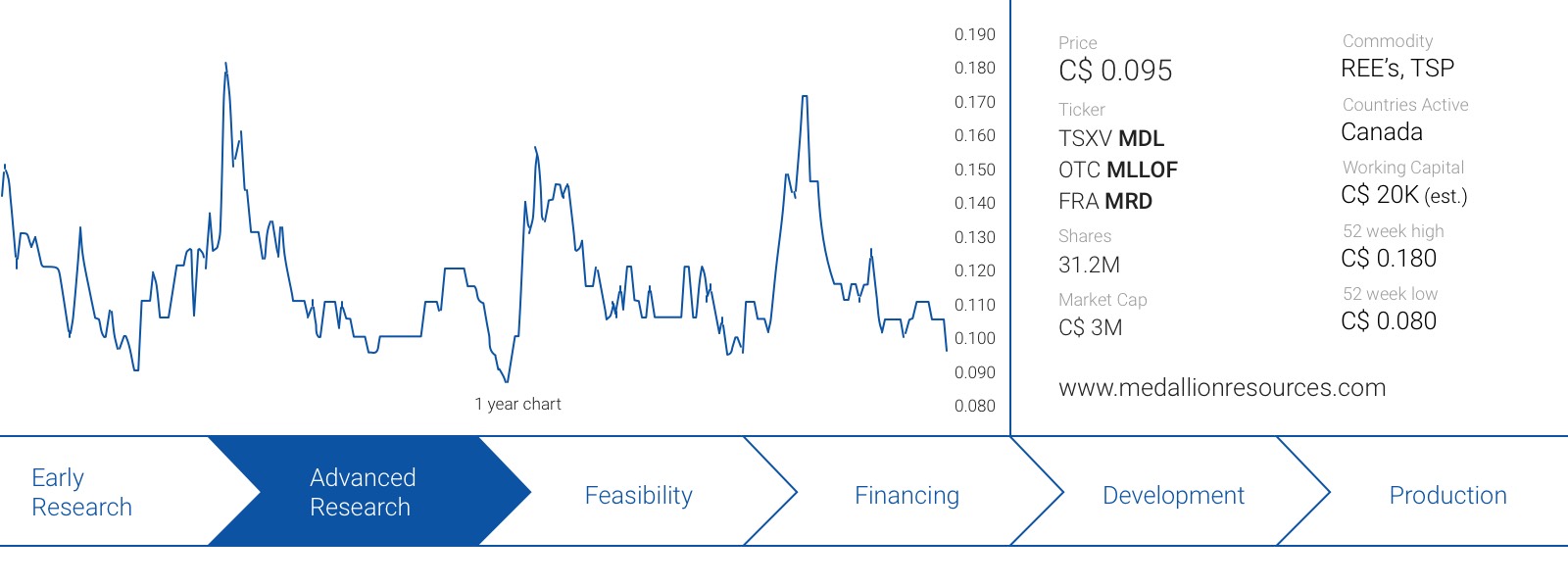
The REE sector is coming back to life, and Medallion Resources (MDL.V) could be one of the companies harvesting the rewards after it continued to invest in test work to determine if it can process monazite to recover Rare Earth Elements. Medallion’s test work indicates its REE concentrate contains high values of Praseodymium and Neodymium, two sought-after elements in the magnet space.
Could you review 2018 for us? What did you work on, and what did the company achieve in the past 12 months?
Medallion made significant progress on developing its process flow-sheet to extract a rare earth concentrate from monazite sand. The test product passed with flying colours from our commercial partner Rare Earth Salts.
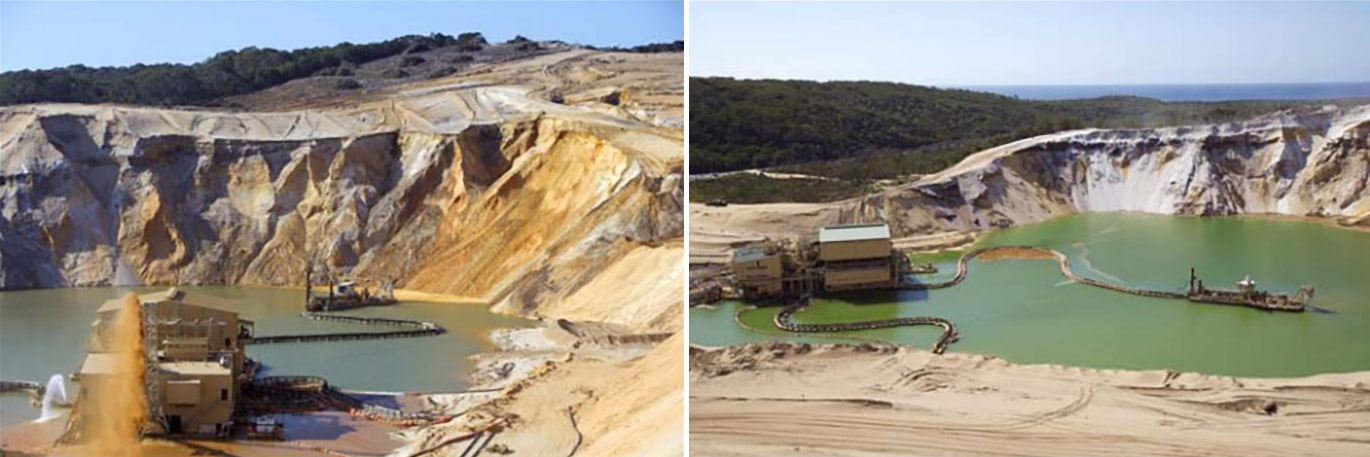
What will 2019 bring? What will you be working on and what budget do you have in mind?
We look forward to completing our process flow-sheet so that we can get preliminary engineering costs on a commercial plant. Also, we look forward to entering into commercial agreements for monazite sand. Rare Earth Salts is also working to sign-up long-term customer agreements for rare earth oxides to be supplied by our feedstock.
What’s your near-term and longer-term outlook for your main commodity?
The long term is looking very positive as the “magnet metals” NdPr, which are required in large quantities in EVs, hybrid cars and wind generators are all expected to be in a long-term growth phase as per the UBS chart below:
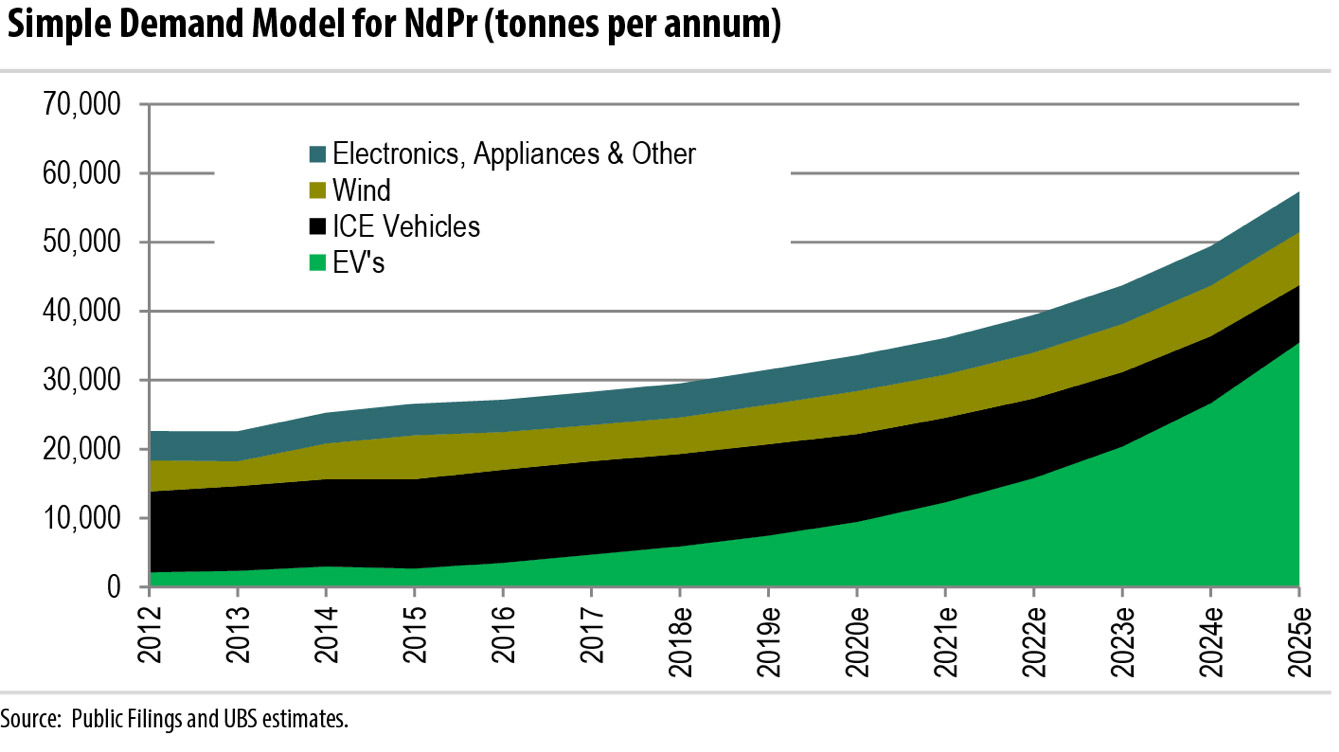
The Chinese have capped production and non of the proposed hard rock mines can get to production within 5 years.
Riverside Resources (RRI.V) has completed a lot of work this year on its gold and copper exploration properties in Mexico. The Company was able to sign a joint venture agreement with Sinaloa Resources which very likely means the exciting high-grade gold-silver project will be drilled in 2019, but on top of that, it advanced several other projects to a drill-ready stage.
We talked to Raffi Elmajian (Corporate Communications) who provided the answers to our three questions.
Could you review 2018 for us? What did you work on, and what did the company achieve in the past 12 months?
Riverside had a good year with a focus on precious metals and some base metal porphyry copper work.
On the precious metals side, Riverside was happy with the positive exploration results in Sonora where the Cecilia Gold-Silver Project is located. We expanded the land package by over 500% to approximately 60 square kilometers to control the entire district and subsequently our follow up exploration work discovered four new target areas at the Project. The field work at Cecilia was positive as we encountered high grade gold results in our sampling program, sometimes exceeding one ounce of gold per ton of rock and we also found new target zones both at the main Cerro Magallanes zone as well as on the 5000 hectare surrounding ground of Cecilia 1. This sets us up very nicely for high potential results early in 2019.
At Tajitos, a second project located in Sonora, Riverside developed high-grade gold target areas that are adjacent to Fresnillo’s (FRES.L) resource and its planned Tajitos open pit mine. We are excited to own such excellent ground with portions of the mineralization that is planned to be mined, which appears to be extending onto Riverside’s ground.
In Sinaloa, the La Silla project with high grades of up to 19.9 g/t Au & 200 g/t Ag makes the project very interesting. Adjacent to our La Silla project, work done by mid-tier and major mining companies like Meridian and Yamana Gold (YRI.TO, AUY) developed resources at their own La Silla veins which extend through Riverside’s large 20 square kilometer tenure package. Partner Sinaloa Resources plans to carry out exploration work in 2019.
On the copper side, Riverside made progress on three properties including the Ariel project where a generative reconnaissance exploration program came up with new target zones. Additionally, Riverside engaged with potential major copper company partners on our Copper projects. We also worked on our two other copper assets (which are also located in Sonora) and we are looking to develop a relationship with a large copper company in 2019, which would really kick-start the exploration activities on the properties.
What will 2019 bring? What will you be working on and what budget do you have in mind?
For 2019 we are set up very well with high-grade precious metal projects including our plans to drill the Cecilia project where we will build upon the fine 2018 results. The drilling could expand the high-grades of surface channel sampling at Cerro Magallanes area and at several areas on the large tenure of the project.
During 2018 Riverside developed new zones and interpretations for the high-grades of silver at the Peñoles project and for 2019 the project will likely progress with a partner funding exploration program toward further development of high grades.
Our partner Sinaloa Resources is expected to conduct mineral exploration and drilling at the La Silla Project in Sinaloa, Mexico and we look forward to seeing some results from that project as well. We are also looking to expand beyond Mexico in 2019 as we are working towards finalizing some opportunities that presented themselves in 2018.
We will obviously also continue to progress the Prospect Generator model with partnerships and potentially a new strategic exploration alliance which could lead to immediate drilling on Riverside’s titled and permitted drill ready projects, which is very exciting.
What’s your near-term and longer-term outlook for your main commodity?
There’s a lot of uncertainty and instability in the world at the moment including interest rates, debt, China, Brexit, and super power jockeying which we see as some factors lining up for an increase in gold price in 2019.
Riverside has been exploring and working up projects during these down markets times positioning ourselves in preparation. Throughout Riverside’s history (which included downturns in the mineral exploration sector), the company has been able to form strategic alliances with companies providing significant generative exploration funding from majors that allowed Riverside to add quality projects to the portfolio that we now own 100%. Riverside continues to build on its 75,000 location database that has significantly enhanced our entire company’s knowledge significantly.
A second key commodity for Riverside is copper, particularly looking at 2019 and 2020. The electricity boom and clean technology changes going on will drive huge demand for copper in the coming decade and we are quite positive on the outlook for the base metal. We are ready for a push on our copper project and are trying to identify potential JV partners and are looking to add more promising copper projects to our portfolio in the next 6-18 months.

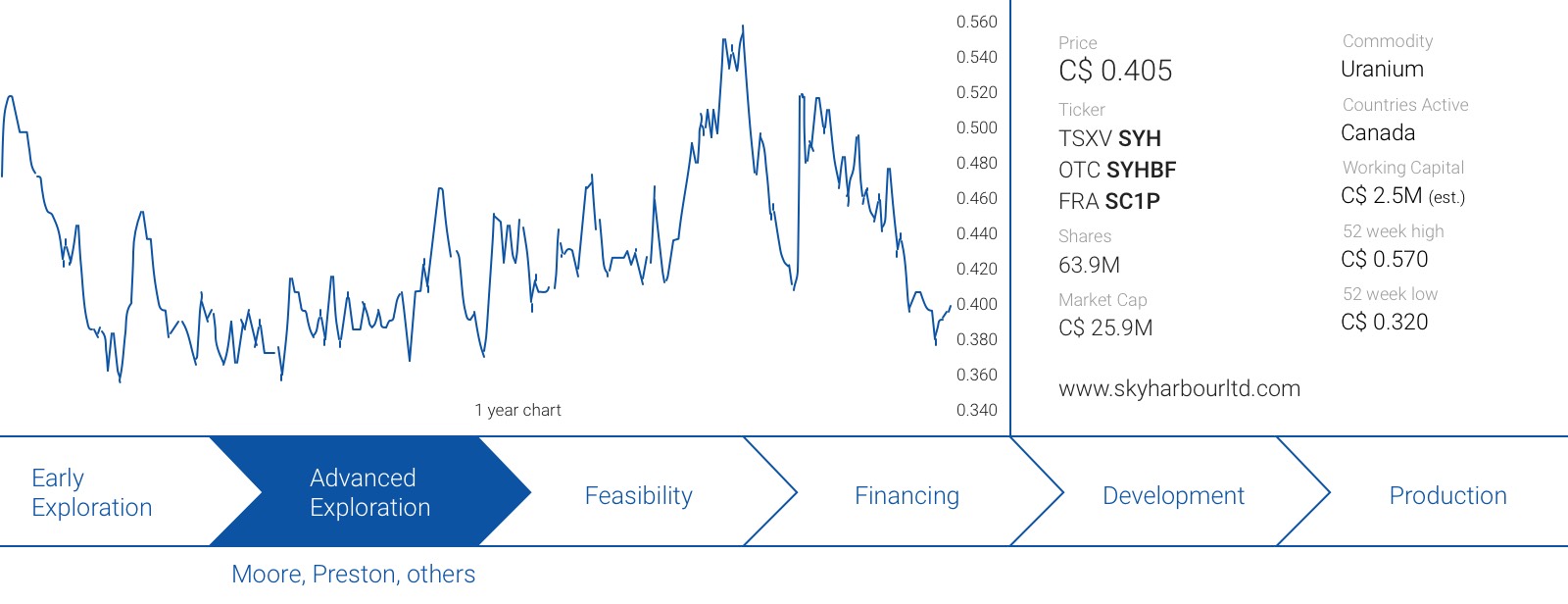
We expect a stronger uranium market in 2019, and Skyharbour Resources (SYH.V) could be an interesting way to gain exposure to the sector. A rising tide will lift all boats and although uranium exploration companies have been slaughtered since Fukushima (only a handful exploration companies were able to survive), we do expect to see renewed interest in the sector.
Could you review 2018 for us? What did you work on, and what did the company achieve in the past 12 months?
Skyharbour had a successful year on the exploration front as the Winter 2018 drill program (which was completed in Q1) encountered more high-grade uranium mineralization at the Maverick zone with 3.5 meters of 2.07% U3O8 and 6.3 meters of 1.01% U308 at relatively shallow depths (265-275 meters down hole). This exploration program allowed us to accelerate the earn-in into the Moore Uranium project and the company has now earned in 100%.
We recently announced the assay results from the Fall 2018 drill program at the Moore Uranium project, which consisted of 3,800 meters in 8 holes. Four holes were exploratory holes which encountered altered lithology, while the other four holes were drill-testing the Maverick Main zone. Of those 4, 2 encountered high-grade uranium mineralization with 15.2 meters of 0.56% U3O8 (including 1.8 meters of 3.11% U308) and 7.8 meters containing 1.33% U308 (including 1.5 meters at 2.91%).
In that hole, which was drilled on the western side of the project, high-grade cobalt and nickel mineralization was discovered over the entire 7.8 meters with a grade of 0.44% Cobalt and 1.62% Nickel. We expect to follow up on this discovery in 2019.
What will 2019 bring? What will you be working on and what budget do you have in mind?
We’re designing a 3,000 meter Winter drill program at Moore Lake where unconformity targets and basement targets along the Maverick corridor will be tested. This will help get a better understanding of the uranium mineralization at Maverick, and should allow for greater efficiency in future drill programs targeting resource expansion.
Additionally, our two joint venture partners, Orano and Azincourt Energy (AAZ.V) are also gearing up for a busy winter season. We are particularly pleased with Orano’s commitment to spend C$2.2M on the Preston uranium property, which will include almost 5,000 meters of drilling. News flow is expected on all three fronts.
What’s your near-term and longer-term outlook for your main commodity?
The uranium market has been improving in 2018 as more analysts are agreeing this could be a sustained upswing considering the fundamentals of the uranium market are probably as strong as the pre-Fukushima era. The global uranium production will decrease to 135 million pounds in 2018 on the back of mine closures, while the demand continues to increase to approximately 192 million pounds. Add the fact the Russian-US relations have cooled down (which reduces the likelihood of the restart of the Russian nuclear warhead uranium supply), and it remains very questionable how the world demand will be met once the sales on the spot market will be gone.
That spot market is already tightening, and the spot uranium price has reached $28.50 per pounds. That’s a good start, but this price is still substantially below the prices needed to sanction the development of new projects or even to re-open projects that are currently on care and maintenance.
Long story short: it’s a basic principle of supply and demand. The demand is there and won’t decrease anytime soon, but in order for the supply increase to be able to meet the demand, a higher uranium price is needed to incentivize producers and developers of uranium projects.
Southern Silver Exploration (SSV.V) made major progress on its 40% owned Cerro Las Minitas zinc-silver project in Mexico. The company published a resource update and continued to intersect mineralized zones that should help it to increase the silver-equivalent resource, which currently stands at almost 210 million silver-equivalent ounces. It’s still very early days and Southern Silver currently has no plans to publish a Preliminary Economic Assessment on CLM, but we already made an attempt to figure out the economics of CLM, and you can re-read our report here.
Since that report was published, Southern Silver released updated and improved metallurgical test work and we will shortly update our expectations using the more recent metallurgical test work ahead of the planned resource update.
Could you review 2018 for us? What did you work on, and what did the company achieve in the past 12 months?
We:
- Published an updated mineral resource estimateof, at a 175g/t AgEq cut-off:
- Indicated – 116.1Mozs AgEq: 33.6Mozs Ag, 319Mlbs Pb and 813Mlbs Zn; and
- Inferred – 7Mozs AgEq: 20.7Mozs Ag, 131Mlbs Pb and 870Mlbs Zn
- Continued to expand the CLM West claim group to +200 sq km to bring the total property package to now 345 sq km.
- Completed a $3.0M exploration program focused on:
- the continued expansion of the mineral resources at Cerro Las Minitas; and
- the further development, through continued surface exploration and drill testing of Ag-Au epithermal vein systems in the more recently acquired CLM West claim group.
In the Area of the Cerro, the drill program was successful in expanding high-grade mineralization at the Las Victorias and North Skarn targets, several hundred metres laterally and down dip. Drilling in the Skarn Front deposit filled gaps in the current block model including a 15.3m (est. TT) intercept averaging 260g/t Ag, 0.18% Cu, 0.9% Pb and 0.1% Zn (317g/t AgEq; 8.9% ZnEq) from Drill hole 18CLM-110. Results from several additional holes are still pending and will be included in an updated Mineral Resource estimate in late Q1 2019.
Exploration in the +200 sq km CLM West claim group focused on the ‘greenfields’ discovery of Ag-Au epithermal vein systems in this largely volcanic terrane which elsewhere hosts major mineral deposits at the Avino Gold-Silver Mine and Coeur Mining’s, La Perciosa deposit. Drilling successfully intersected a strongly anomalous silver intercept averaging 168g/t Ag over 3m and thicker zones of strongly anomalous As-Sb ‘pathfinder’ elements. Drilling tested the Durazno breccia, a strongly oxidized and brecciated structural zone that can be traced discontinuously for over 1.5 kilometres on the CLM West property before plunging under gravel cover to the south. Only one hole has tested this newly identified target; more work and drill testing is planned in 2019.
Earlier metallurgical work on the Skarn Front had copper in the form of chalcopyrite report to the zinc concentrate resulting in dilution of both zinc grade and recovery. Work in 2018 successfully removed the chalcopyrite from the zinc concentrate, effectively creating three high-grade base metal concentrates (Zn, Pb, Cu) with over 84% of silver reporting to the copper and lead concentrates.
What will 2019 bring? What will you be working on and what budget do you have in mind?
Current budgets for 2019 are contemplated in the $2M to $3.5M range. Funds will be used to:
- Update a mineral resource calculation in late Q1 2019 based on the 2018 exploration results;
- Continue systematic resource expansion in the Area of the Cerro toward a near to mid-term goal of +300Mozs AgEq;
- Continue targeting of Ag-Au quartz vein systems in the CLM West claim group toward the identification of a brand new, high-grade, precious-metal-rich mineral deposit.
What’s your near-term and longer-term outlook for your main commodity?
Zinc 2019 Outlook: expected to remain in supply deficit for a third year in a row despite increasing supply with mine production up 4.6%; however, China’s environmental protection continues to pose supply risks.
Silver 2019 Outlook: forecasted to outperform gold; supply is expected to decrease in 2019 due to lack of new mines and expansions.
Lead 2019 Outlook: to remain in supply deficit supporting prolonged high lead prices.
Copper 2019 Outlook: higher demand (renewable energy, electric vehicles), modest deficit, 3% production increase will create a balanced market. Projected to hold current price levels or move slightly higher.
Disclosure: All companies mentioned are sponsors of the website, and we have a long position. Please read the disclaimer



































